Tom's Hardware Verdict
The Core i9-10850K gives you the same gaming performance as the world's fastest gaming chip, the Core i9-10900K, but at a lower price point, making it a great choice for performance fanatics.
Pros
- +
Cheaper than Core i9-10900K, but with similar gaming performance
- +
Strong in both single- and multi-threaded applications
Cons
- -
Power consumption
- -
Thermal output and cooling requirements
- -
PCIe 3.0 interface
- -
Little overclocking headroom
Why you can trust Tom's Hardware
The 10-core 20-thread Core i9-10850K has landed in our lab, bringing with it nearly identical specifications as Intel's halo Core i9-10900K that holds the crown as the world's fastest gaming processor (albeit by a slim margin) in our CPU Benchmark Hierarchy.
In many respects, the Core i9-10850K feels like a price cut that comes disguised as a new product. A scant 100 MHz of frequency separates it from the $488 Core i9-10900K, but the 10850K's recommended price of $453 represents a 7% savings. Given the price gouging we've seen on the 10900K due to its spotty availability, we expect the price deltas to be even larger at retail. That makes the 10850K a contender for our list of Best Gaming CPUs.
As you'll see below, the Core i9-10850K offers nearly the same level of performance as the 10900K in the majority of our gaming tests, and very similar performance in our suite of application workloads.
The slight difference between the two chips raises the question: Why did Intel release the 10850K three months after the Comet Lake-S launch?
There are a few possibilities, but they're interrelated. Despite the 10900K's impressive performance in gaming, it brings along some baggage in the form of intense power consumption and heat generation that require a bevy of high-priced accommodations, like a premium motherboard, cooler and power supply. That magnifies the 10900K's high up-front pricing. Those factors make AMD's ultra-competitive Ryzen 9 3900X, which retails for $100 less and doesn't require such extravagant accommodations, a better value if you aren't looking to pay a hefty premium to eke out the very last few fps of gaming performance. The Ryzen 9 3900X also excels in threaded workloads, making it more attractive for the productivity-minded.
The 10900K is a high-priced and high-performing product with a limited target market, but Intel has had problems filling that niche. The Core i9-10900K has suffered from spotty availability in the US. It is also consistently out of stock overseas, which has led to price gouging from retailers and exacerbates the already-high pricing.
It's rational to assume the availability issues stem from the 10900K's position at the top of the Comet Lake-S binning chart – it's a premium-binned chip and there simply might not be enough chips coming out of that fabs that land on the higher end of the binning distribution, making it hard to satisfy demand. The resulting price gouging only serves to widen the pricing gap between Intel's halo model and AMD's competing chips that already hold several key advantages.
Get Tom's Hardware's best news and in-depth reviews, straight to your inbox.
Conversely, the 10850K obviously falls into a slightly lower position on the binning chart, which could boost Intel's production capacity and help address the obvious demand for the unlocked Core i9 chips. We imagine that would take some pressure off of the 10900K and result in better pricing and availability all around.
The end result for you? A chip that will largely provide identical performance to the Core i9-10900K, but at a discount. Let's take a quick look at the Core i9-10850K at stock settings, overclocked settings, and with the power limits removed, which equates to a simple form of quasi-overclocking.
Core i9-10850K Pricing, Specifications and Availability
The Comet Lake architecture, which comes with the 14nm++ process, is yet another Skylake derivative, meaning most performance gains come from added features and clock rate improvements. We've covered the finer details here, but like the Core i9-10900K, the 10850K has an unlocked multiplier that enables easy overclocking, solder TIM to boost overclocking capabilities, and doesn't come with a bundled cooler. As before, be sure to price in a Z-series motherboard and a capable cooling solution, preferably liquid, if you're off to the overclocking races.
| High End Mainstream | MSRP/Retail | Cores / Threads | Base / Boost GHz | L3 Cache | TDP | PCIe | Memory | Graphics |
| Ryzen 9 3950X | $749 / $739 | 16 / 32 | 3.5 / 4.7 | 64 | 105W | 24 Gen4 | Dual DDR4-3200 | N/A |
| Ryzen 9 3900X | $499 / $434 | 12 / 24 | 3.8 / 4.6 | 64 | 105W | 24 Gen4 | Dual DDR4-3200 | N/A |
| Core i9-10900K / KF | $488 (K) / $472 (KF) | 10 / 20 | 3.7 / 5.3 | 20 | 125W | 16 Gen3 | Dual DDR4-2933 | UHD 630 - 1.2 GHz (non-F only) |
| Core i9-10850K | $453 / | 10 / 20 | 3.6 / 5.2 | 20 | 95W | 16 Gen3 | Dual DDR4-2933 | UHD 630 - 1.2 GHz |
| Core i9-10900 / F | $439 / $422 (F) | 10 / 20 | 3.7 / 5.2 | 20 | 65W | 16 Gen3 | Dual DDR4-2933 | UHD 630 - 1.2 GHz (non-F only) |
| Core i9-9900K / F | $488 / $524 | 8 / 16 | 3.6 / 5.0 | 16 | 95W | 16 Gen3 | Dual DDR4-2666 | UHD 630 - 1.2 GHz (non-F only) |
| Core i9-9900 | $449 | 8 / 16 | 3.1 / 5.0 | 16 | 65w | 16 Gen3 | Dual DDR4-2666 | UHD 630 - 1.2 GHz |
There isn't much to chew over here. Compared to the Core i9-10900K, the i9-10850K comes with an across-the-board 100 MHz reduction in the base and boost frequencies. The ten-core 20-thread chip runs at a 3.6 GHz base frequency, peaks at 5.2 GHz, and retains all of Intel's normal boost mechanisms (like Turbo Boost 2.0, 3.0, and Thermal Velocity Boost).
Intel hasn't announced or listed a graphics-less Core i9-10850KF model, so it's unclear if it will bring a reduced-cost version of the 10850K to market. As you can see, the 10850K already encroaches upon the locked Core i9-10900's pricing territory. The 10900 isn't overclockable and is only $14 less, with the only advantage being a 100 MHz higher base frequency. As a result, the 10850K is the better buy for most of us.
Intel lists the Core i9-10850K with a 95W TDP, meaning it falls into a lower TDP bracket than the Core i9-10900K. That's largely an inconsequential metric because Intel's TDP rating doesn't have a direct correlation to power consumption, and it only applies to performance at the base frequency when the processor isn't under full load.
We turn to Intel's power level ratings for a more accurate look at power consumption. At stock settings, the 10850K has the same 125W PL1 (power level 1 - at base frequency) and 250W PL2 (power level 2 - at all-core boost frequency) rating as the Core i9-10900K. Motherboard vendors can, and do, ignore those limits, so motherboard quality and BIOS settings will have an impact on performance.
Test Setup and Overclocking
We're using the same test systems that we used for our recent string of Comet Lake-S and AMD Ryzen XT reviews (listed at the bottom of the page). We're sticking to current-gen chips for this round of testing, as the generational performance deltas for both series of chips are already well known.
We've tested the Core I9-10850K at the stock settings on the Gigabyte Aorus Z490 Master, but be aware that all motherboard makers tune their boards based on the capabilities of the power delivery subsystem. This involves adjusting power limits and Turbo Boost duration, among other optimizations hidden in the lines of the BIOS code. Intel gives motherboard makers wide latitude to modify 'stock' performance, so your mileage may vary. For stock testing, we disabled the Multi-Core Enhancement (MCE) feature (it's essentially overclocking).
We overclocked the Core i9-10850K and found that it had the same overclocking capabilities, and at the same voltages, as our Core i9-10900K. That said, this isn't guaranteed - Intel provided our test sample, we have a sample size of one, and you're still at the whims of the silicon lottery in the retail market. In either case, the 10850K cements Intel's winning position in the Intel vs AMD CPU battle.
Much like the situation we find with AMD's Ryzen 3000 series processors, our overclocking efforts found that we couldn't sustain an all-core overclock that matches the single-core boost watermark, but we did pull off an all-core 5.1 GHz overclock. We dialed in a 1.3V vCore to sustain the 5.1 GHz core clock and also dialed the ring bus multiplier up to 48 to improve stability and performance. We also set the memory at DDR4-3600 with 16-18-18-36 timings, just like with the Core i9-10900K.
For our original 10900K review, we tested our overclocked 10900K with the Load Line Calibration (LLC) set to auto. For this round of testing, we retested the overclocked 10900K and 10850K with LLC set to level four. This reduces the chance of motherboard-imposed influences on our apples-to-apples overclock testing. We also retested the Core i9-10900K at stock settings for good measure to employ the same BIOS settings to both chips, which granted the 10900K a larger lead than we originally recorded in some workloads.
We also tested a quasi-overclocked 10850K configuration by removing all power and Turbo Boost limits on the Gigabyte Z490. This quick and dirty technique allows the chip to run at its maximum turbo frequencies and exceed the typical boost duration while consuming as much power as it can handle. This certainly isn't as efficient (especially in terms of power and efficiency) as manual overclocking, but it gives us a taste of the 10850K's unrestrained performance. We listed that configuration as "Core i9-10850K Unlimited" in the charts. All other overclocking details can be found in the reviews of the chips in our test pool.
Intel Core i9-10850K Gaming Performance
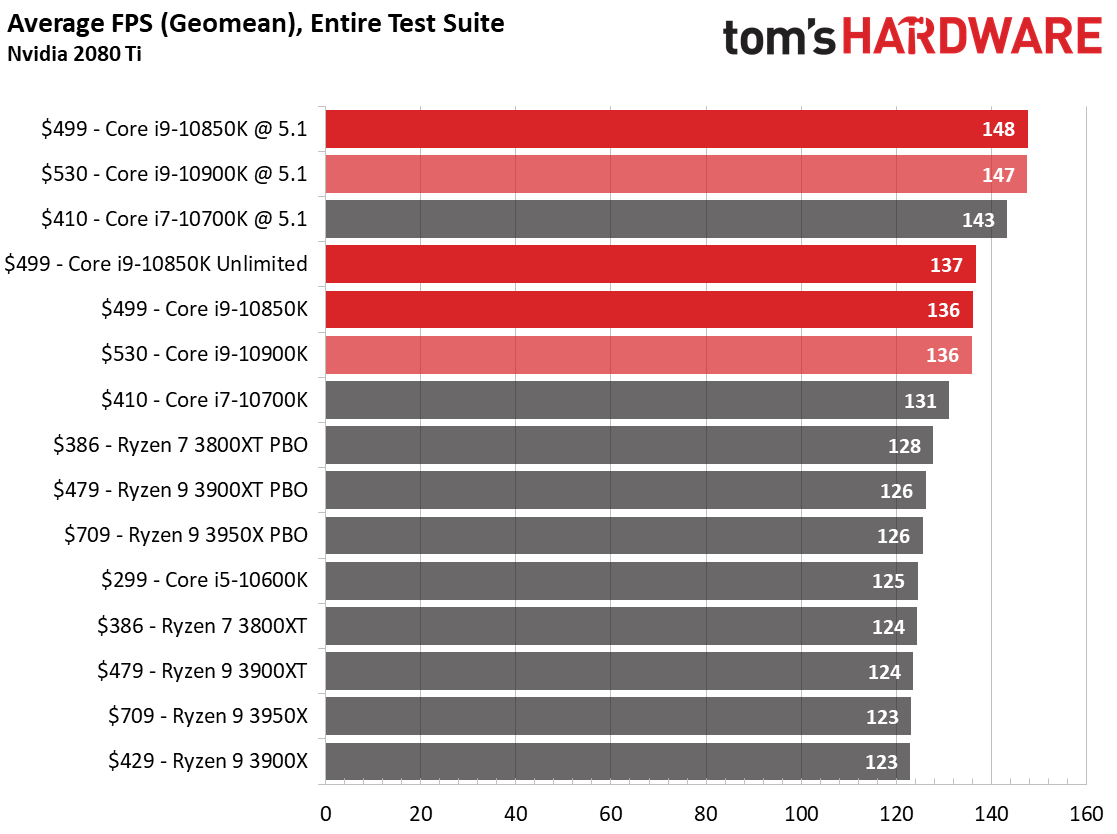



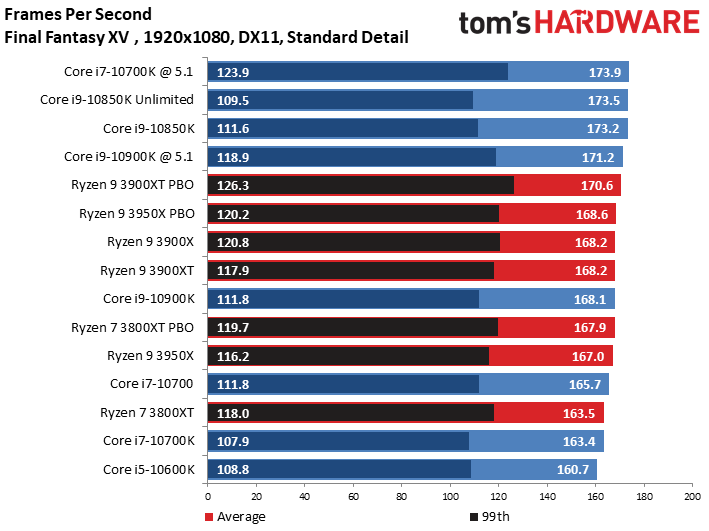
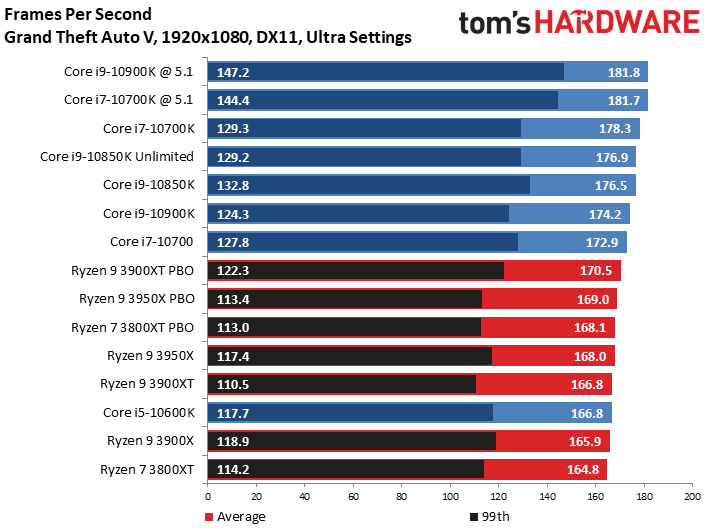
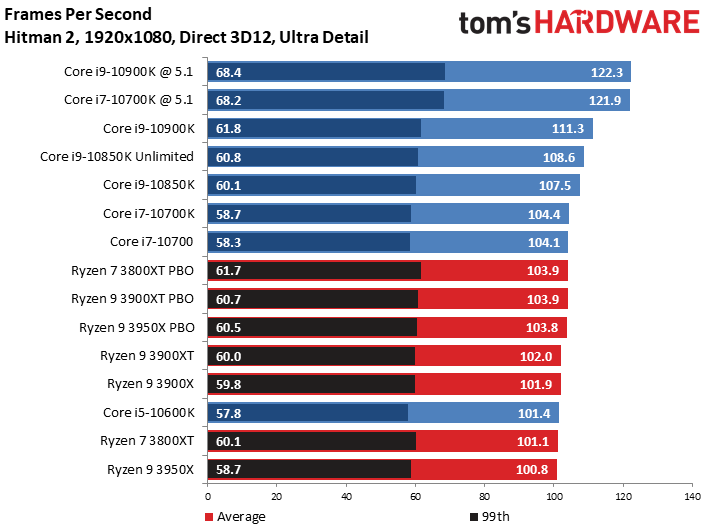
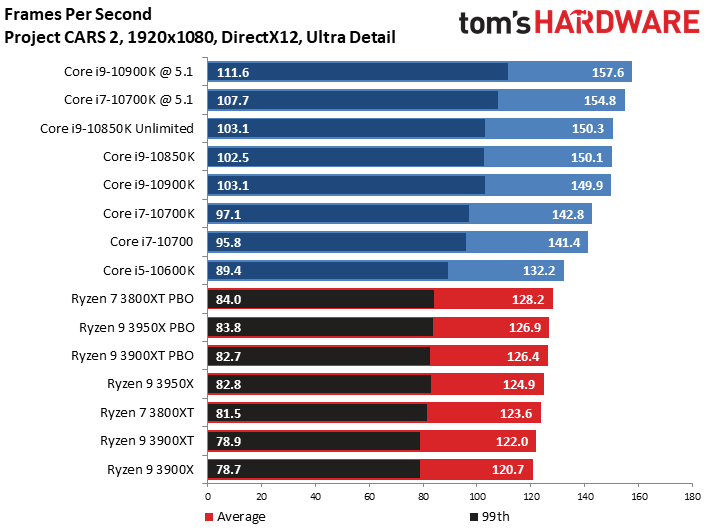
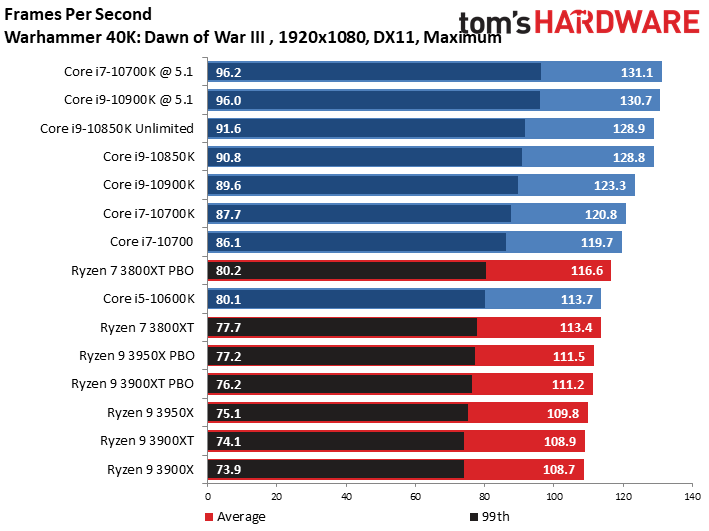
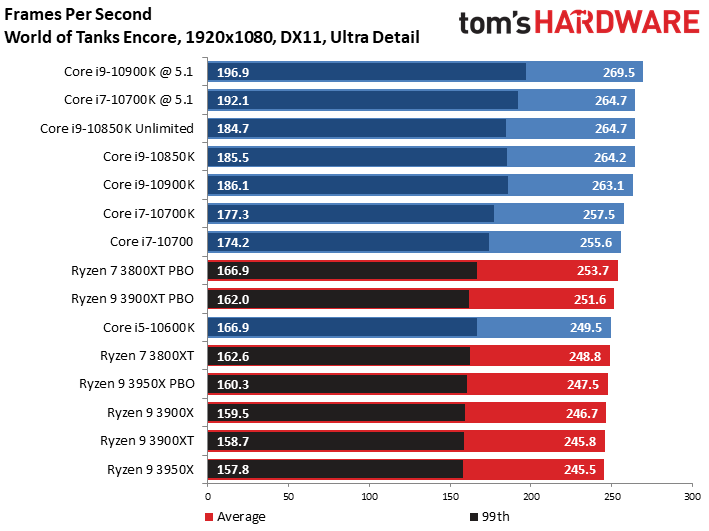



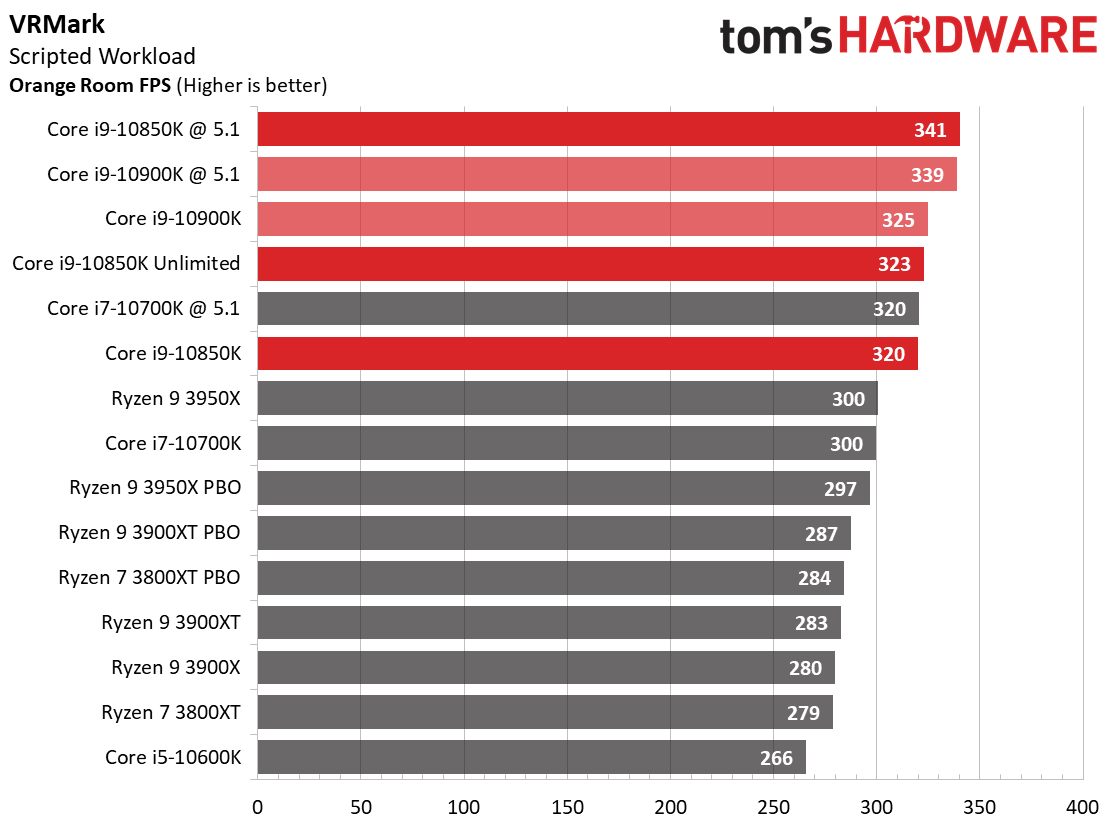
The first chart in our album sums the situation up nicely: The stock Core i9-10850K and Core i9-10900K offer the same performance when calculated as an overall measure (geometric mean) of our gaming test suite. Our test suite is, admittedly, geared more for exposing CPU performance deltas than you would see in a graphics card review, but these trends should persist in most titles. The Core i5-10850K also provides identical 99th-percentile performance, meaning it runs games just as smoothly as its more-expensive counterpart.
After overclocking, the difference between the two chips is meaningless - they perform nearly identically. This doesn't assure that all 10850K's will have the same overclocking headroom, but it does imply that the 10850K holds a premium spot on Intel's binning distribution.
Flipping through the album of gaming results shows some back and forth between the stock 10900K and 10850K in the various titles, but we can chalk most of these deltas up to run-to-run variation that stems either from the title itself, or dynamic clock and voltage adjustments that can vary based on certain conditions. There are a few exceptions - the 10850K scores a decent win in Final Fantasy XV, while the 10900K excels in Ashes of the Singularity and Hitman 2. However, the general trend is undeniable - these chips are shockingly similar in terms of real-world gaming performance.
Intel Core i9-10850K Rendering Performance
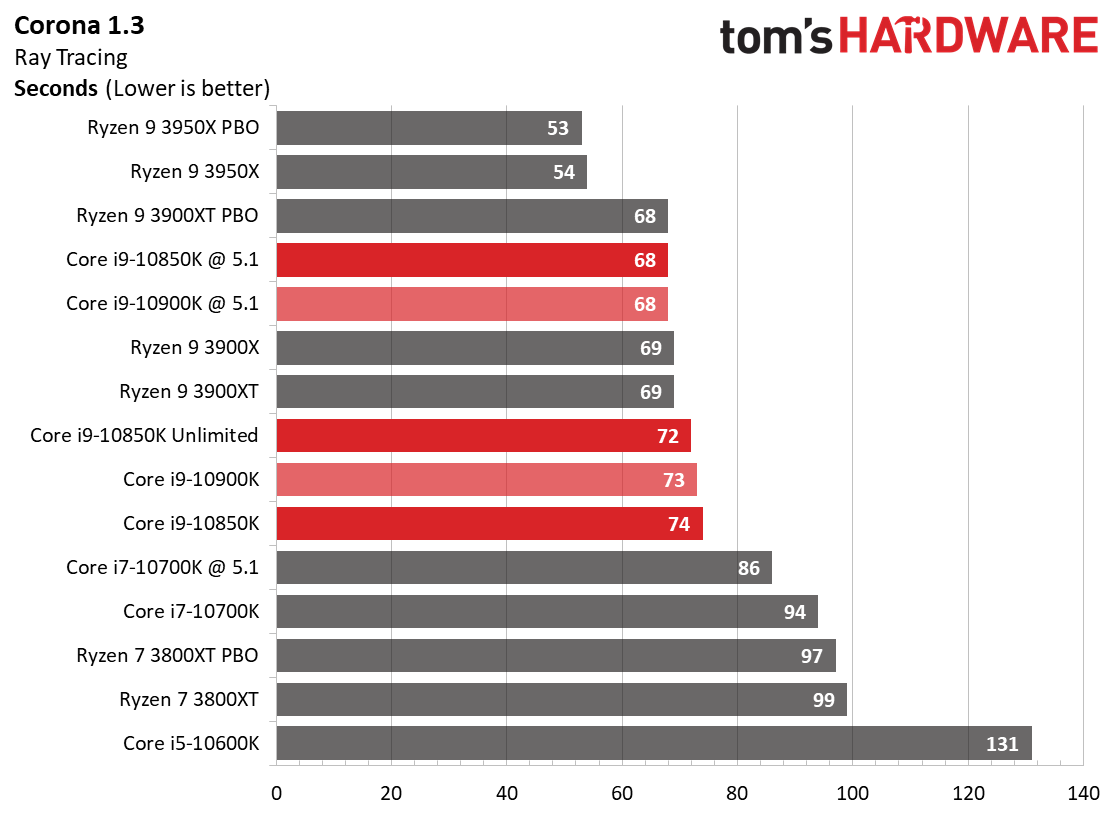
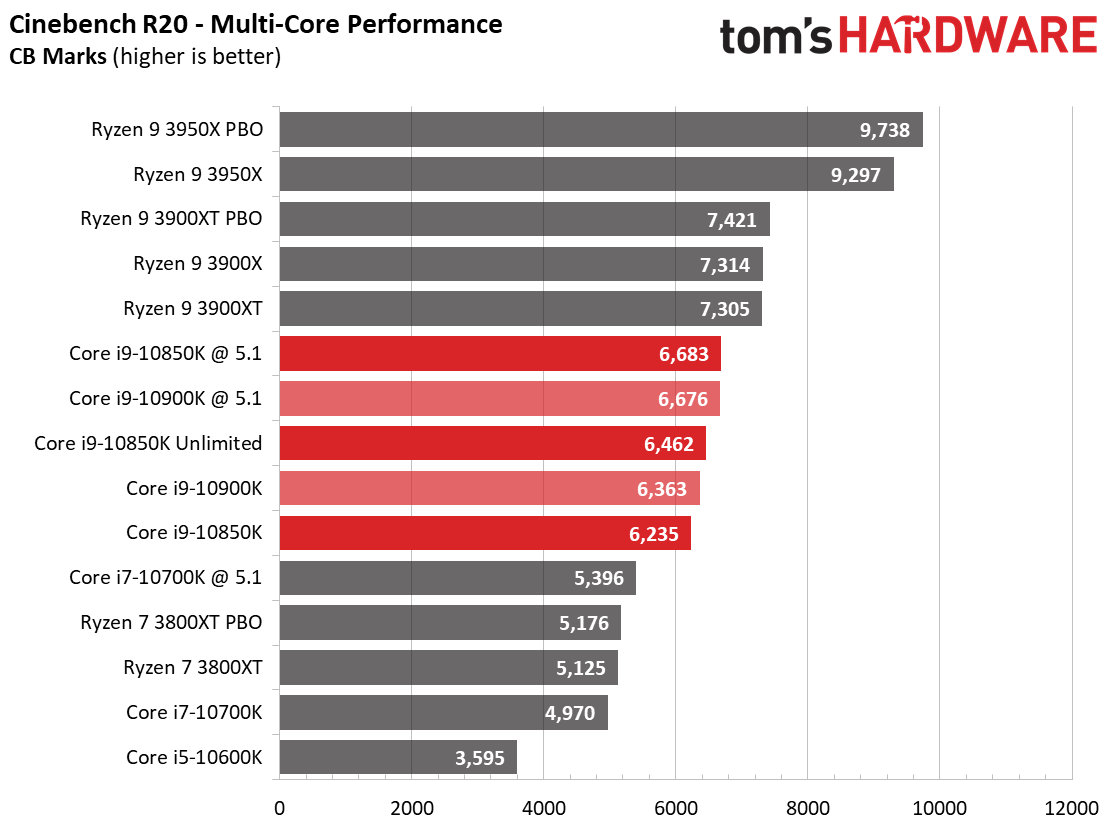
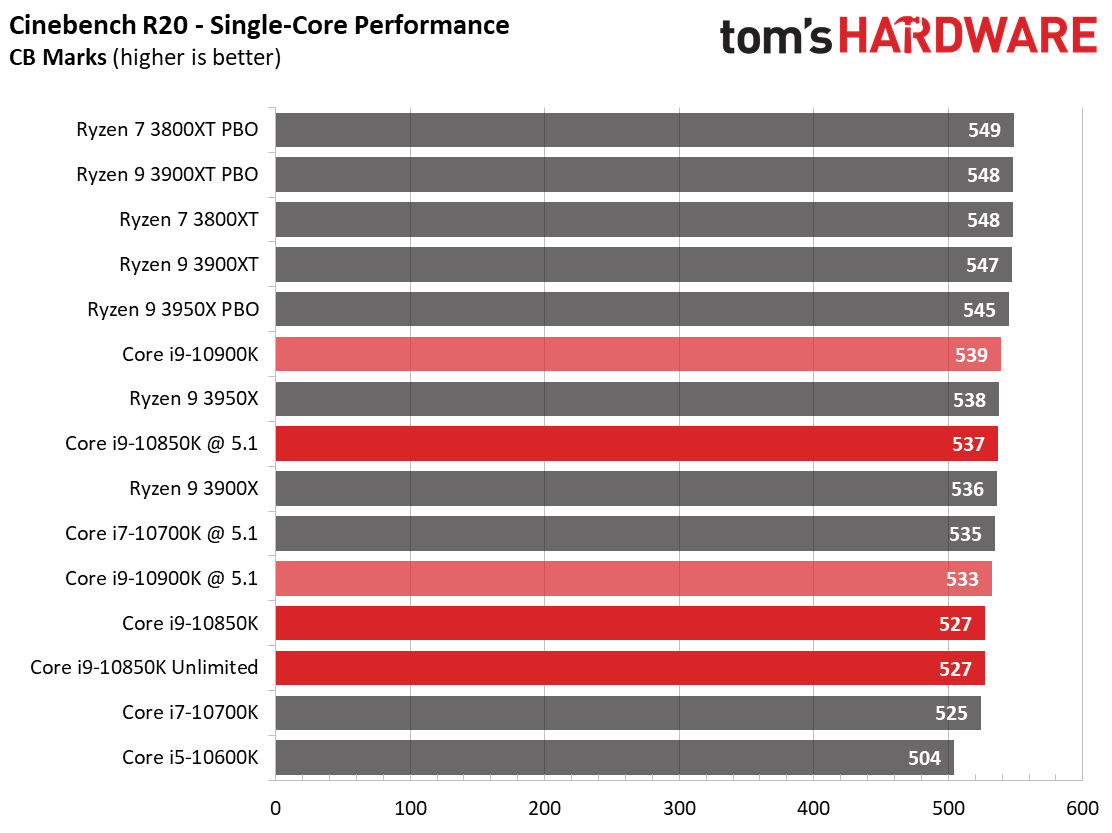

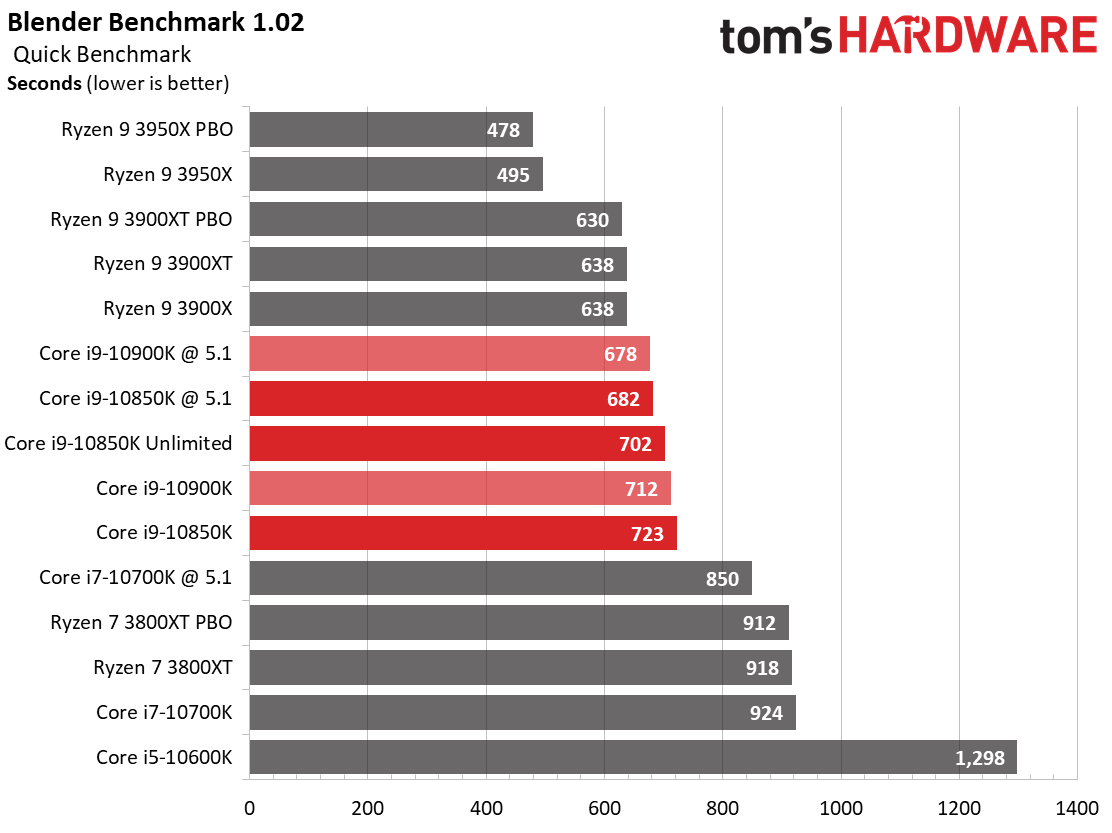
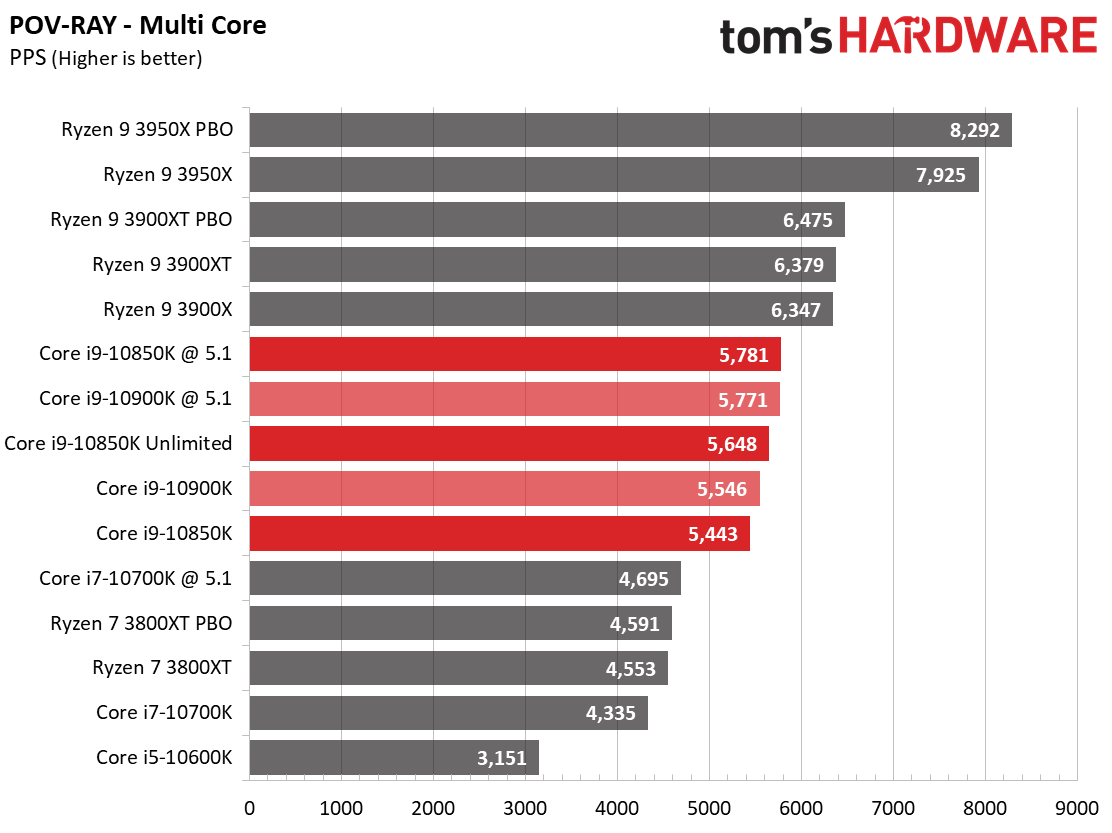
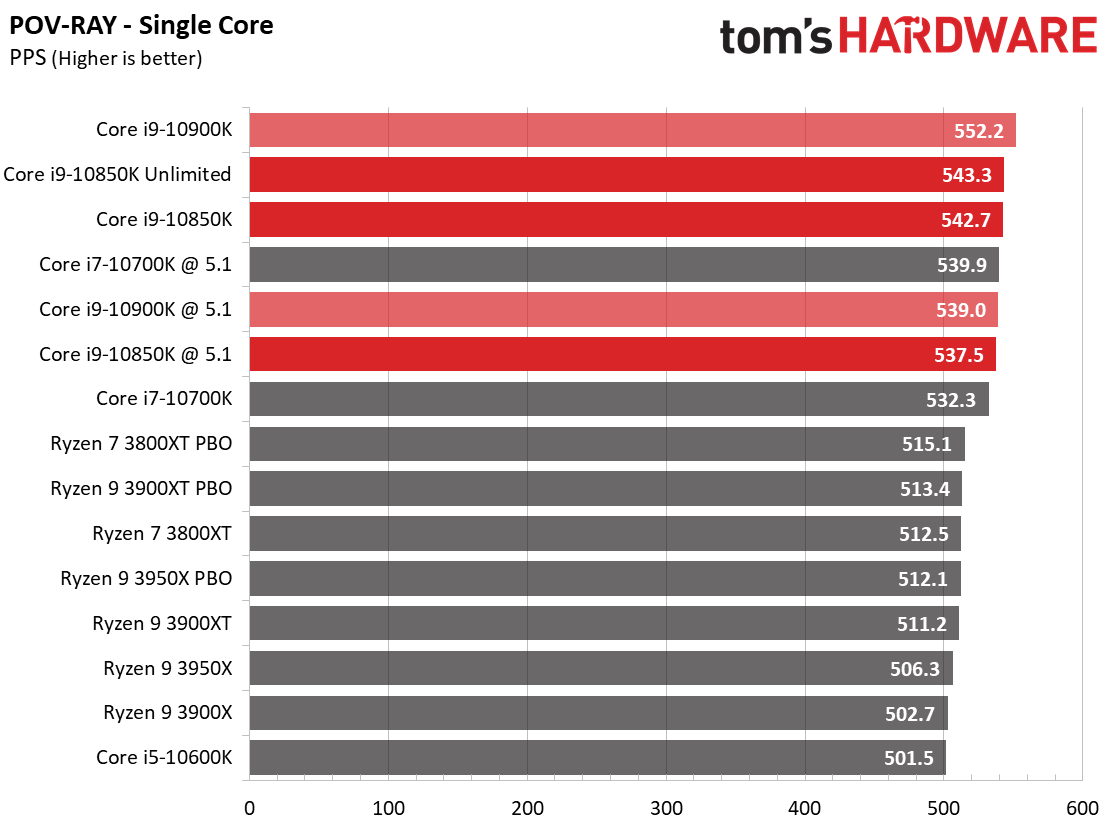
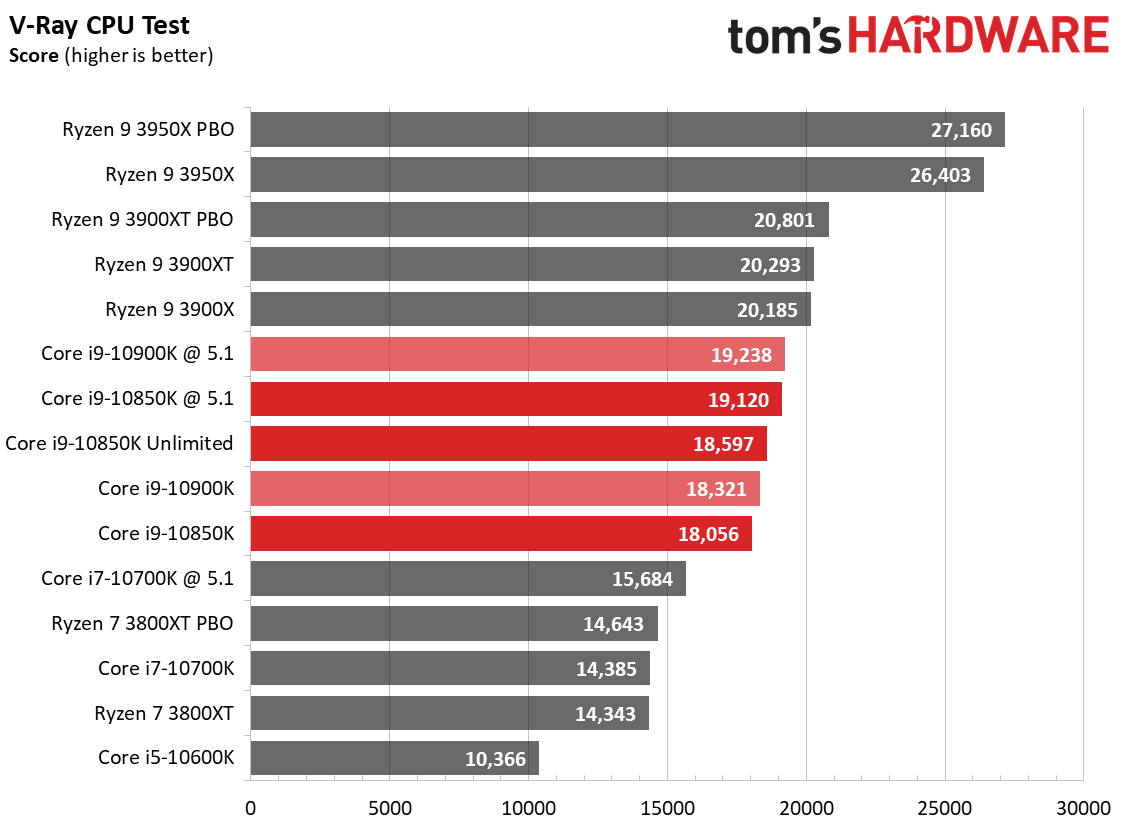
We see more pronounced differences in our spate of threaded application workloads, but as you'll see in the overall measurements at the end of the article, the trends are largely the same as we observed in gaming.
The Core i9-10900K has a slightly higher boost frequency that is more impactful as the workload spreads across more cores and benefits from parallelization in multi-threaded Cinebench and POV-ray tests, and the higher single-core boost also helps in the single-threaded iteration of those tests.
There aren't any remarkable performance deltas between the two chips at stock settings - the Core i9-10900K generally holds a performance advantage. As we know from our previous tests, Intel's Core i9-10900K runs right at the limit of the attached cooler, often throttling even at stock settings, and we observed much of the same tendency from the 10850K in our stress tests. That means that even though we used the same Corsair H115i cooler for these tests, ambient temperatures and cooler mounting can have a larger-than-normal impact on performance.
Intel Core i9-10850K Encoding, Compilation and AVX


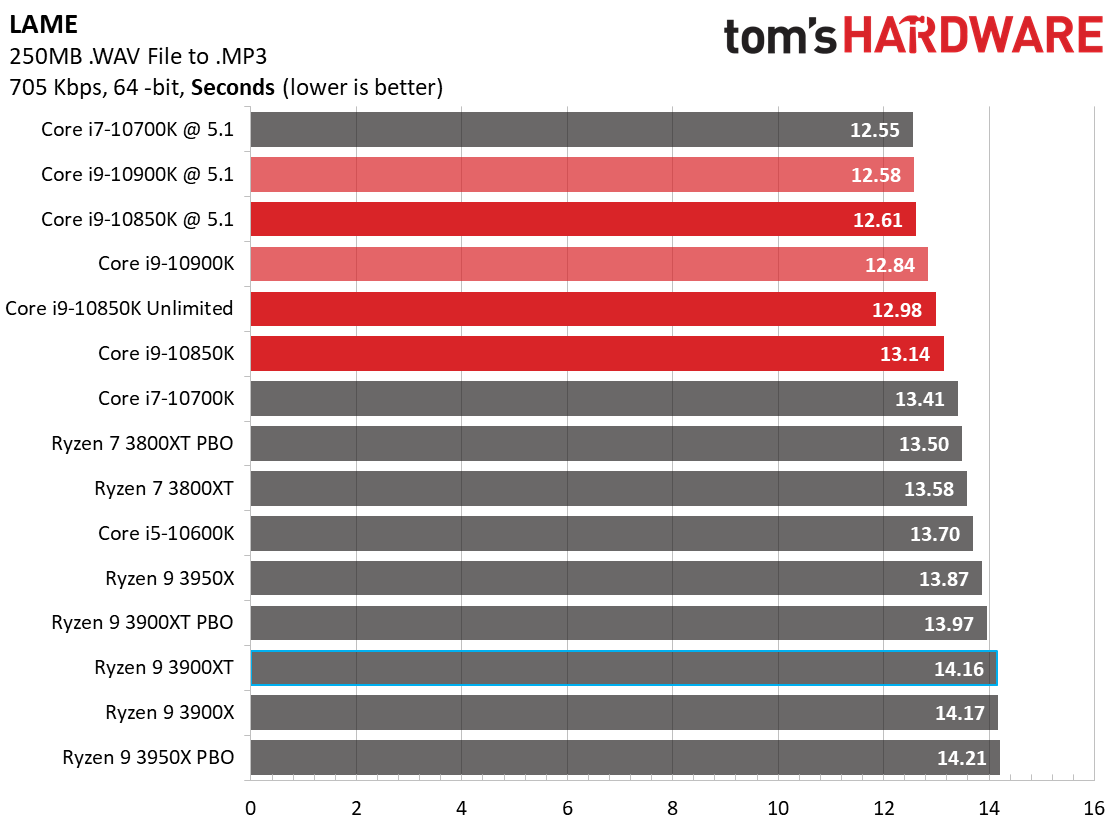
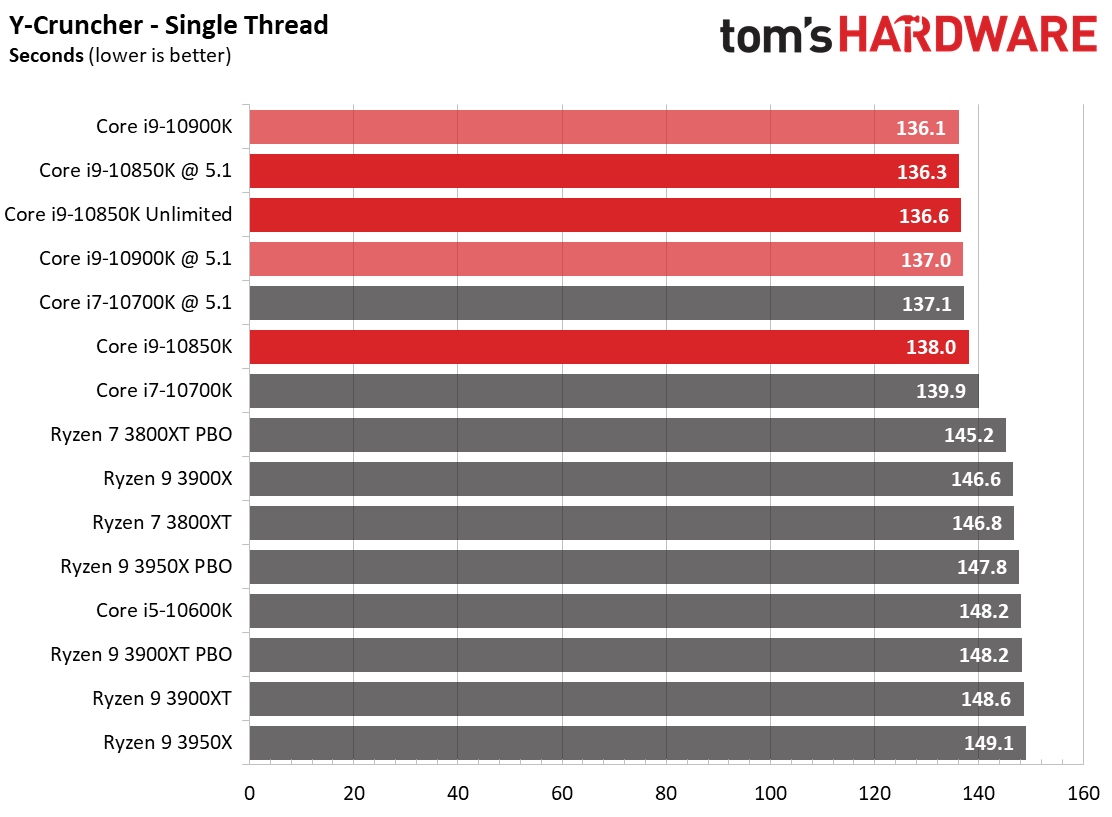
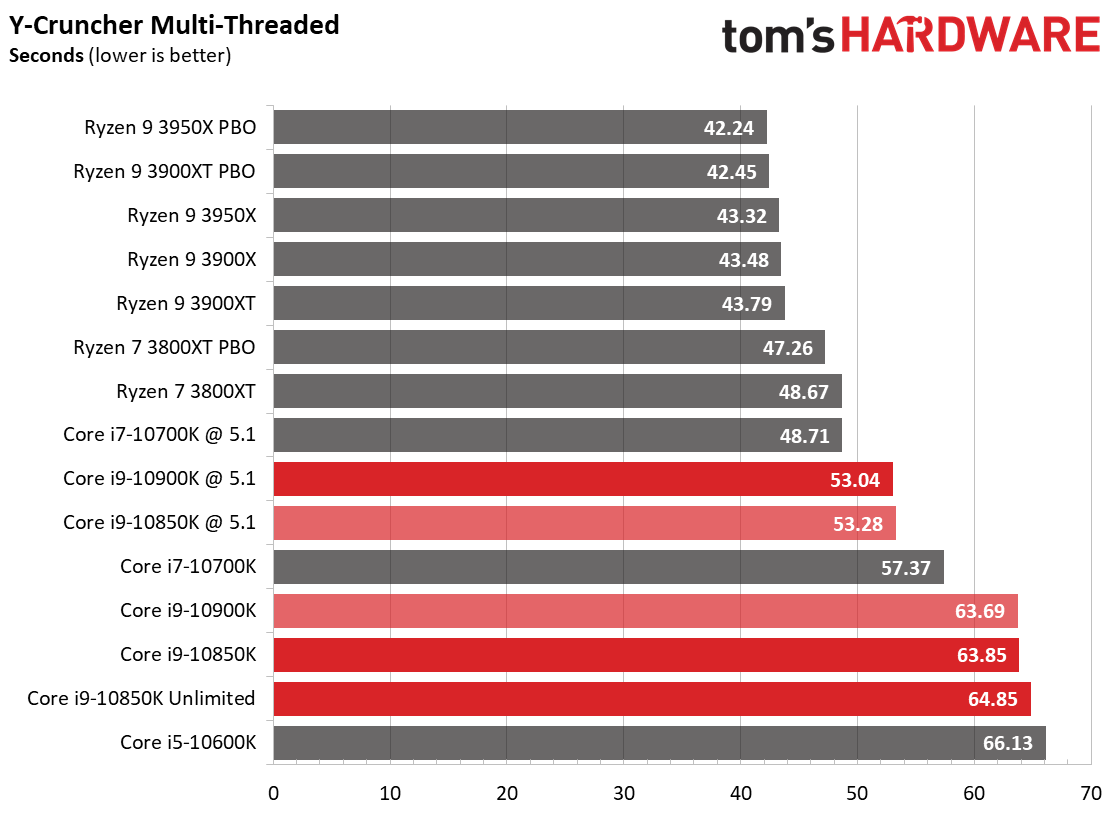
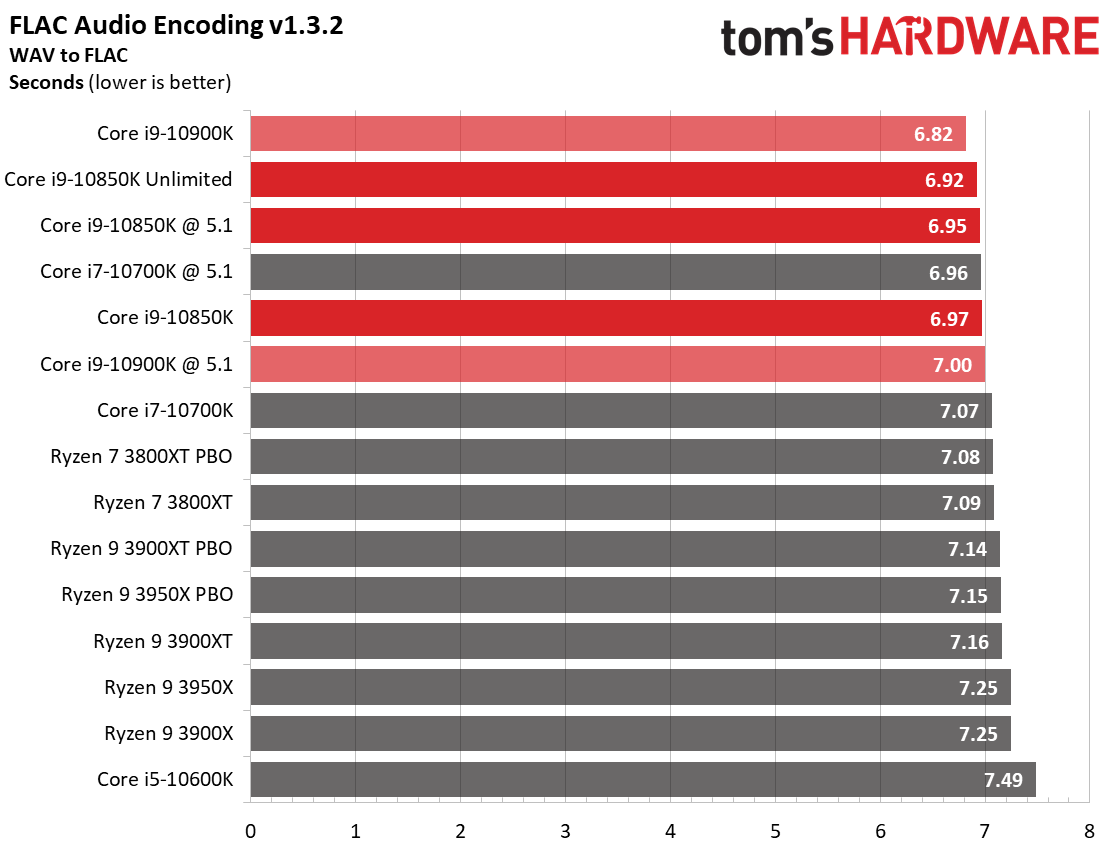

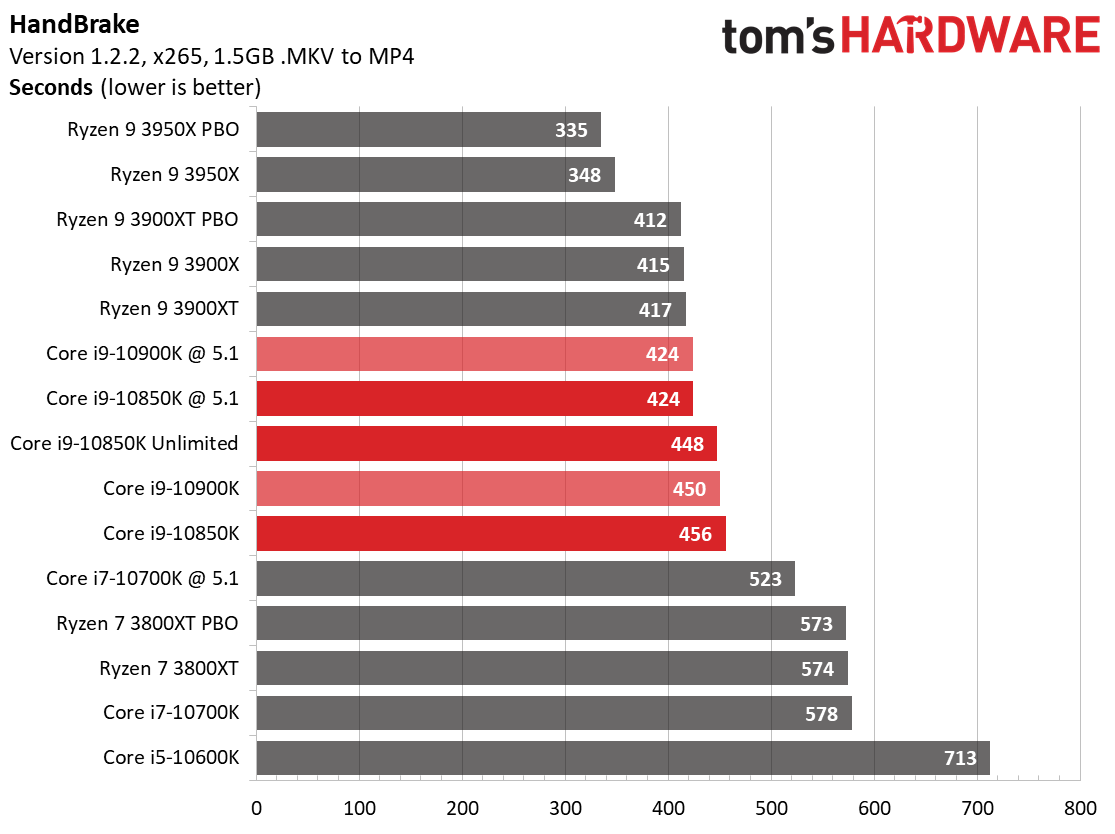
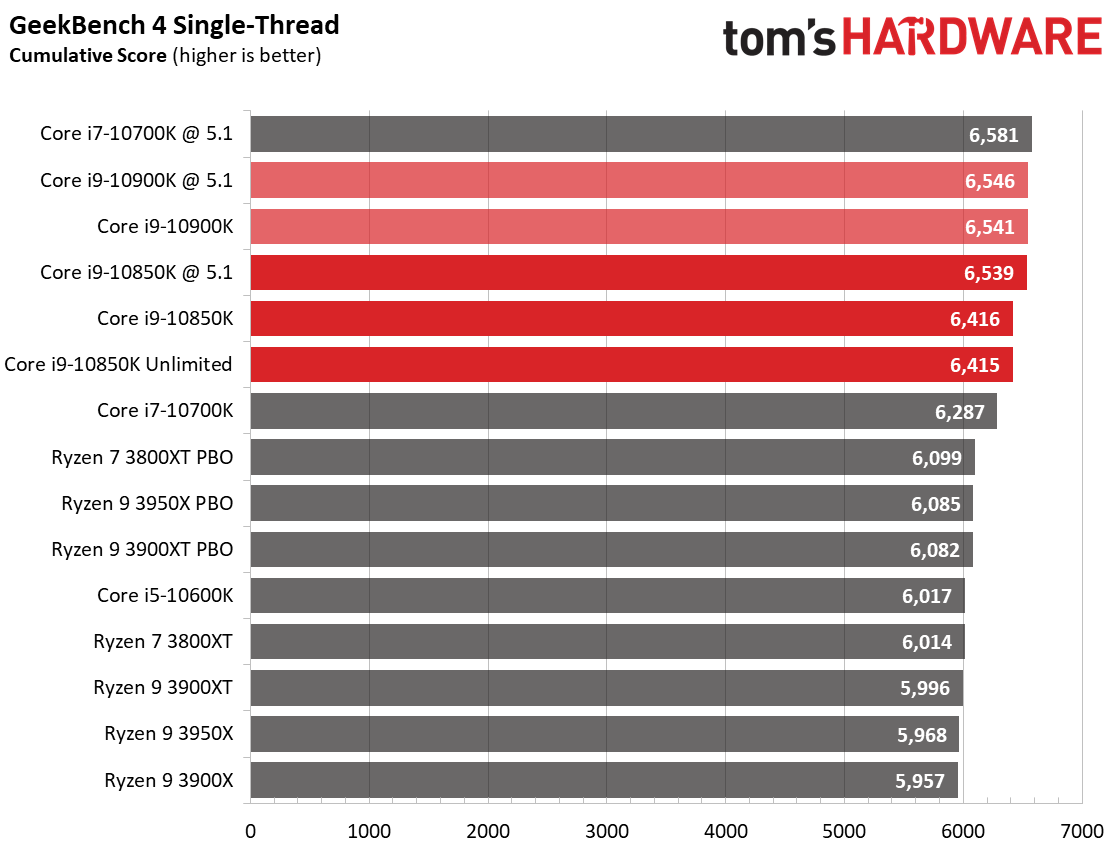

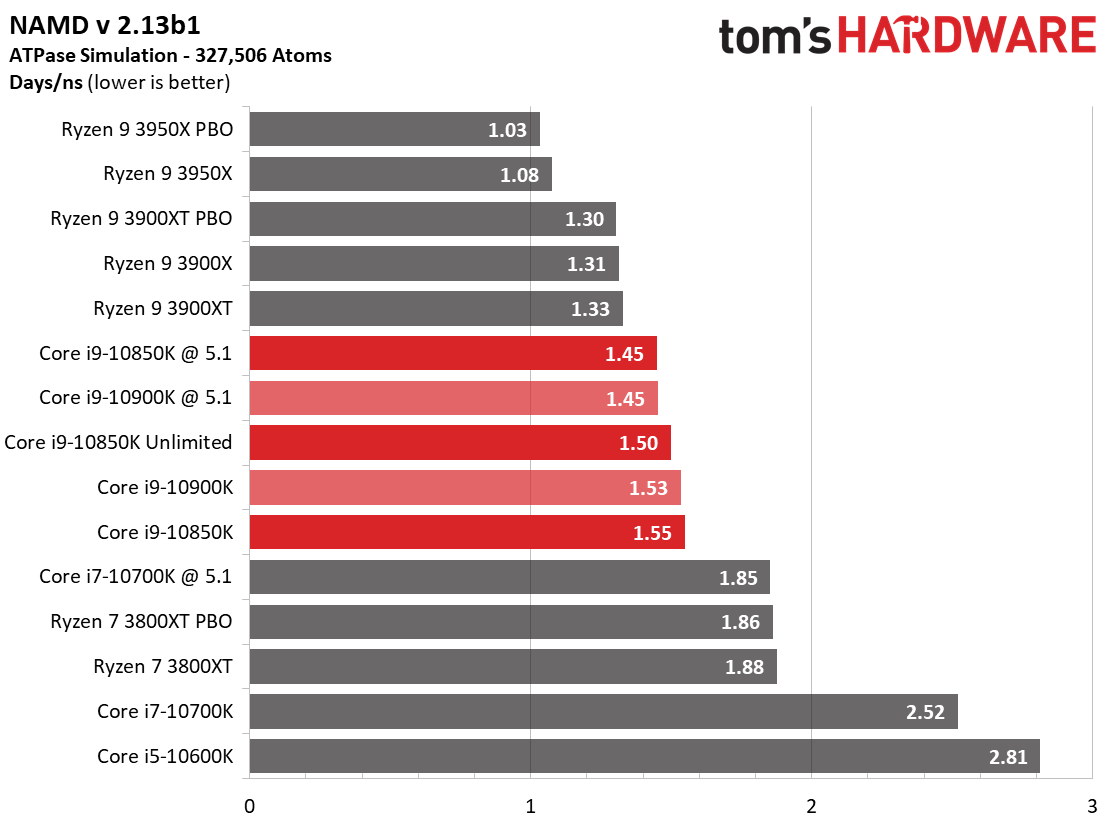


We notice some varying performance deltas between the Core i9-10900K and 10850K, with a wider gap separating the two in lightly-threaded applications, while deltas tend to be minimal in threaded scenarios. These results generally align with our expectations given the 10900K's higher frequency rating.
Core i9-10850K Web and Office
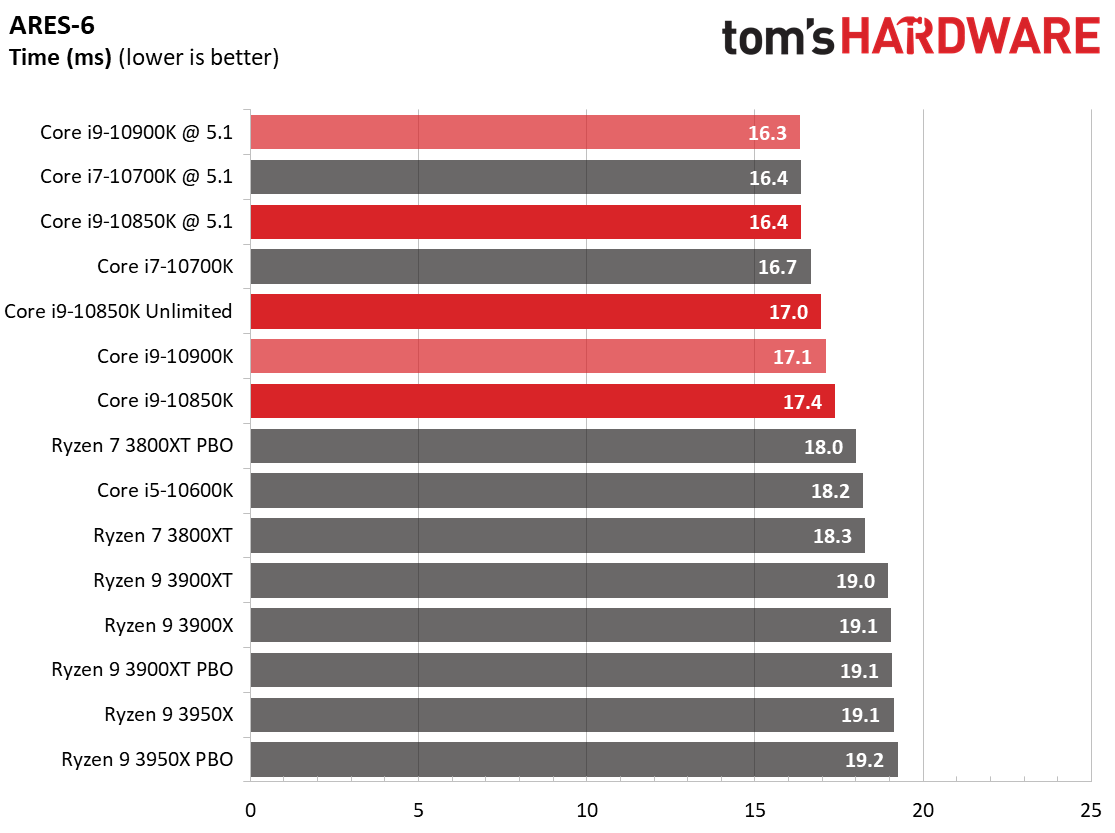
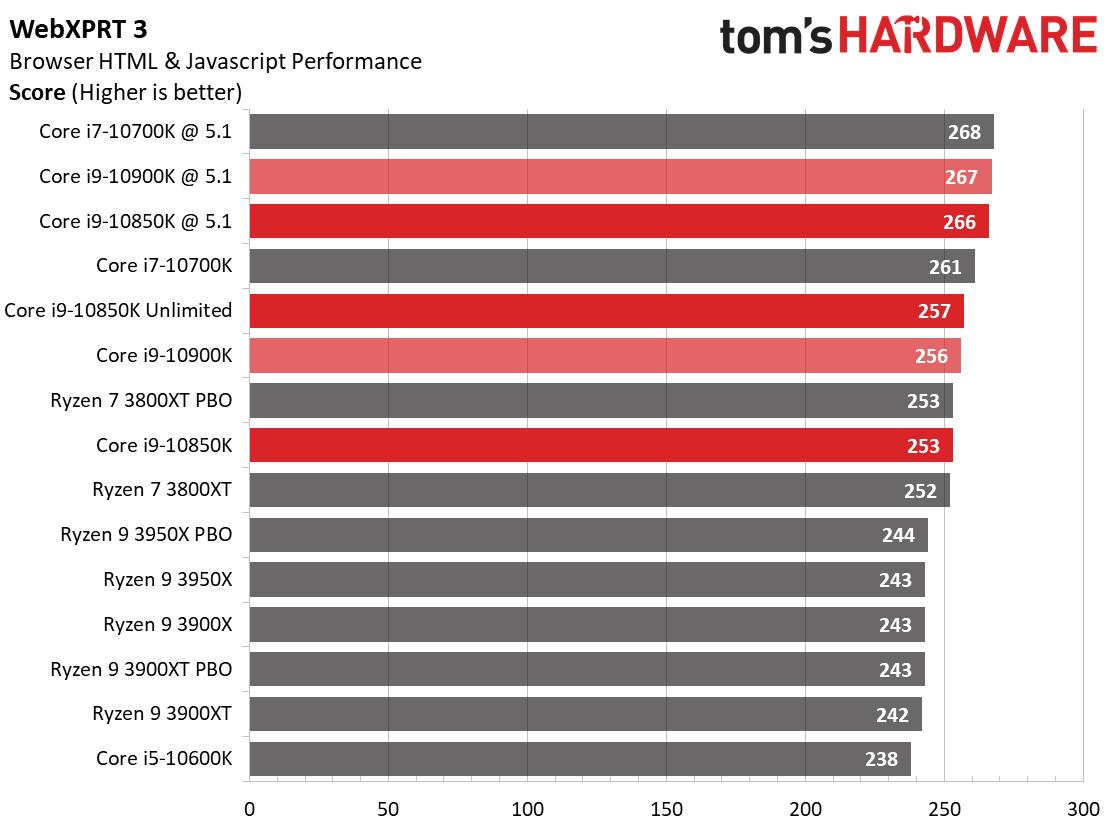
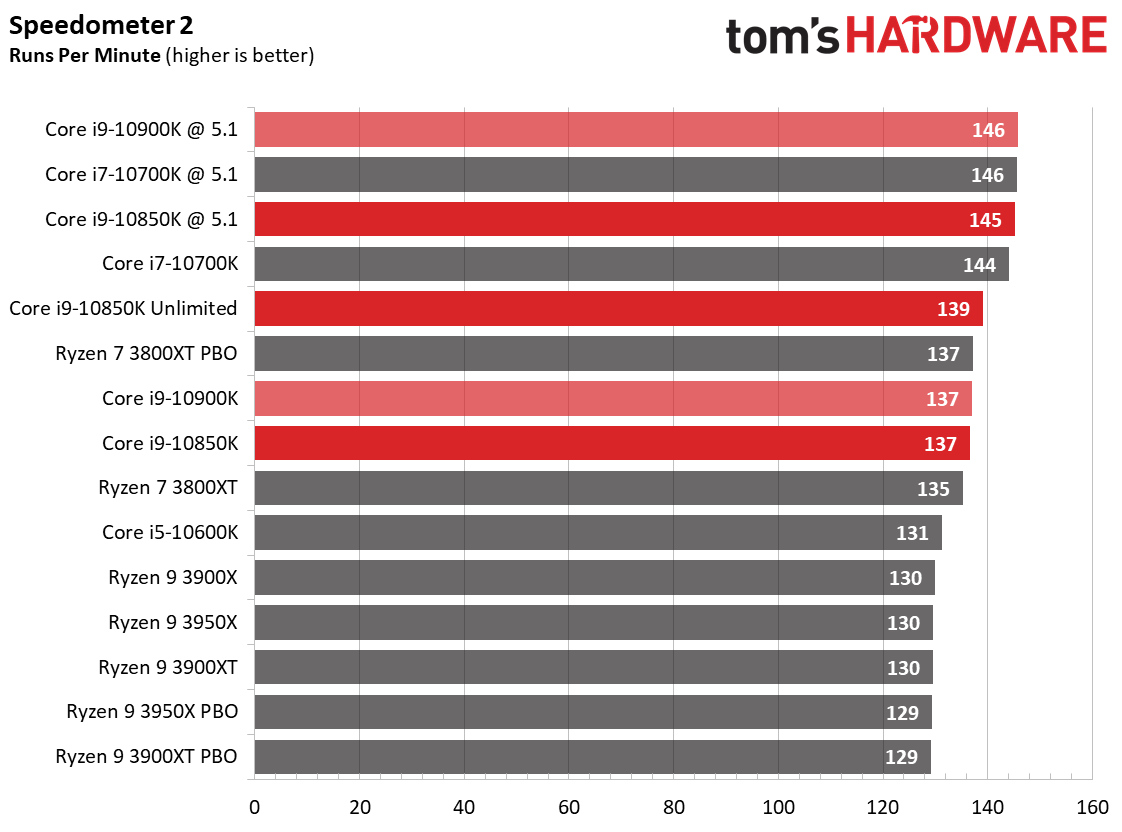


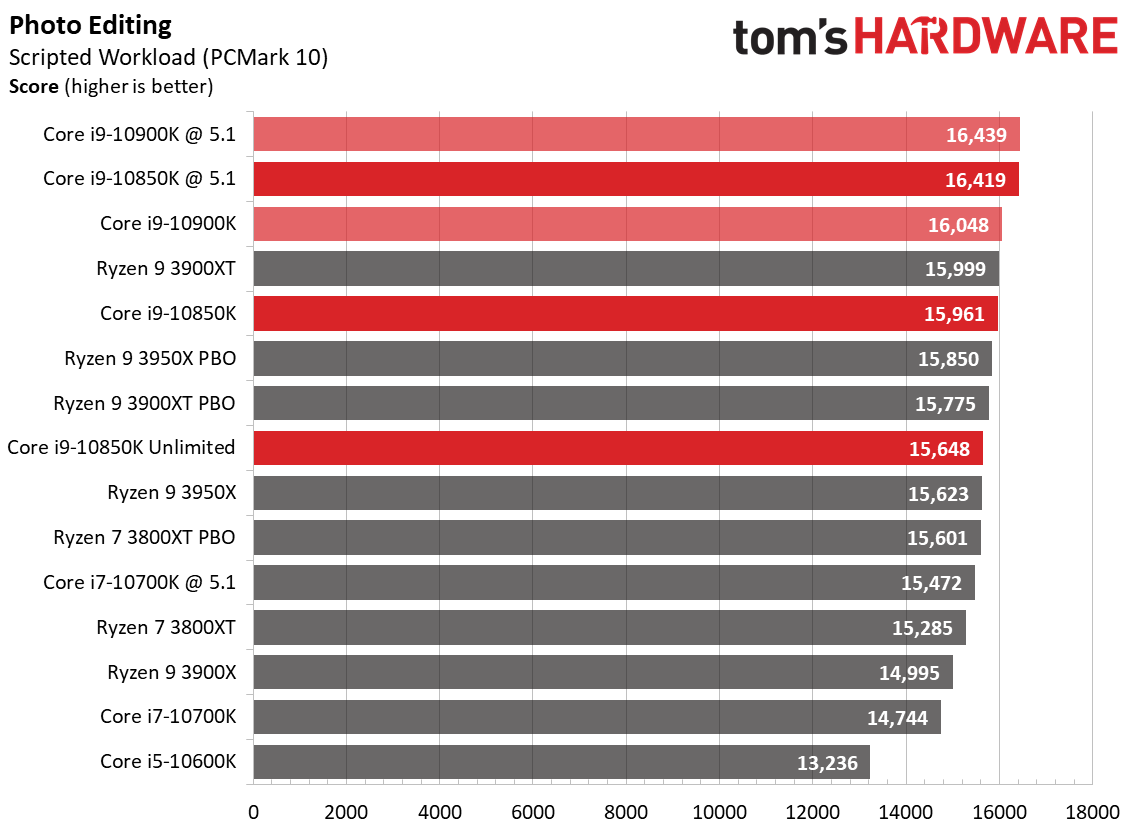

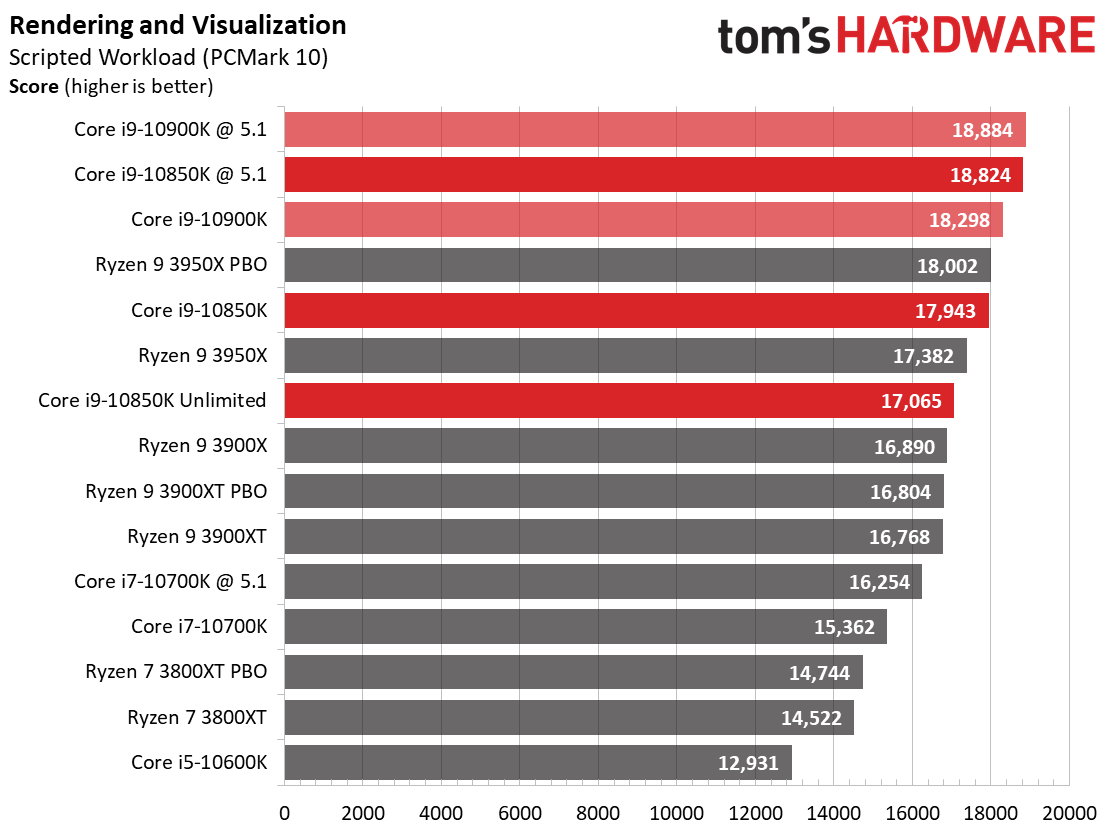
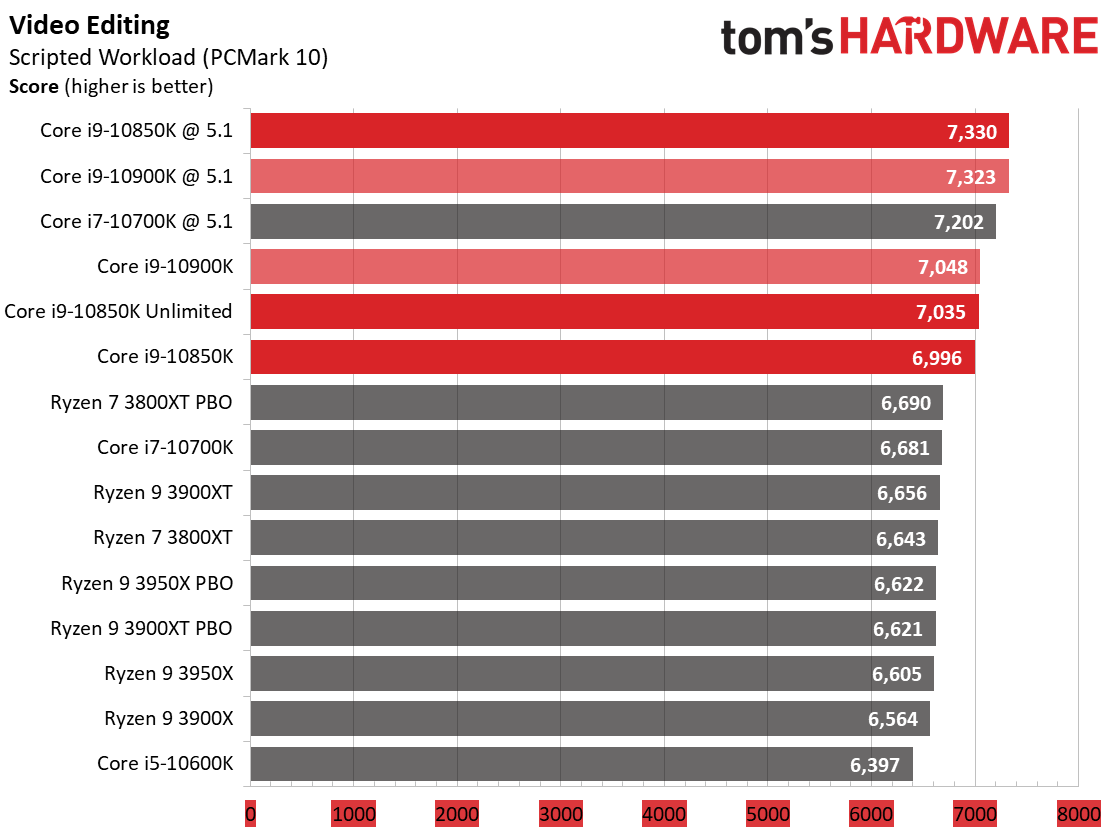


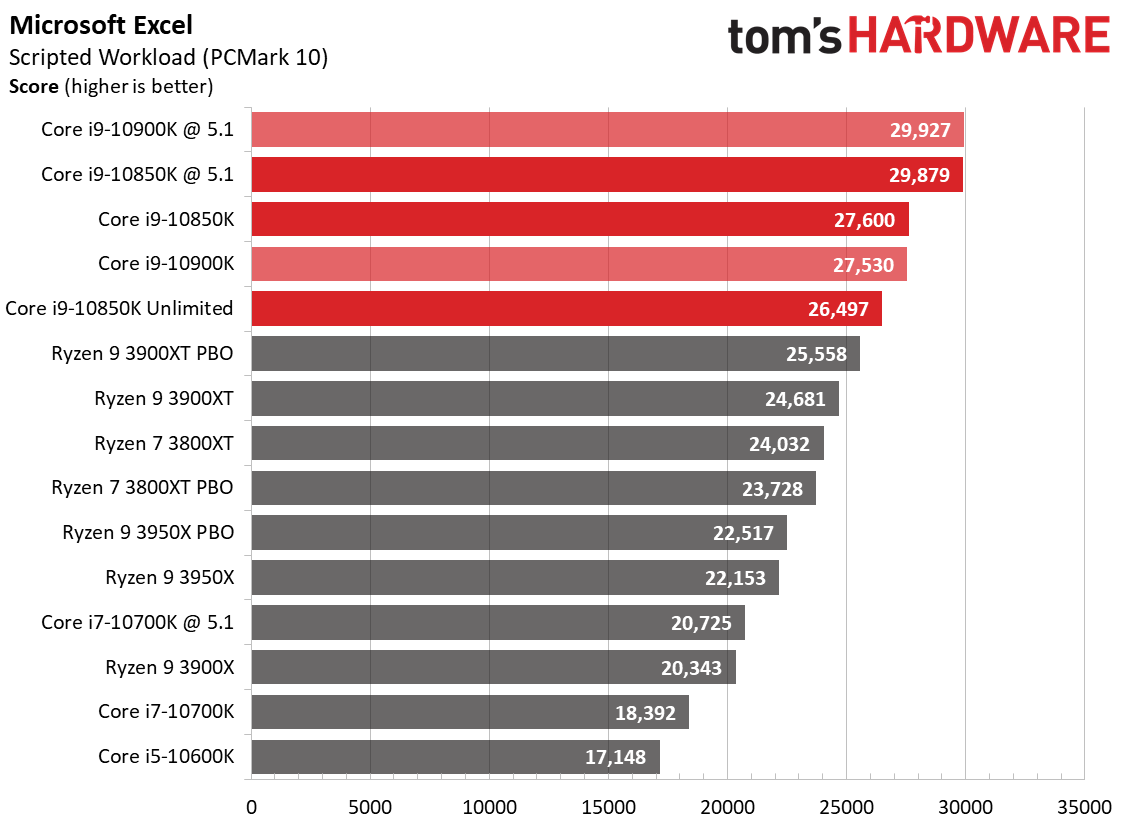
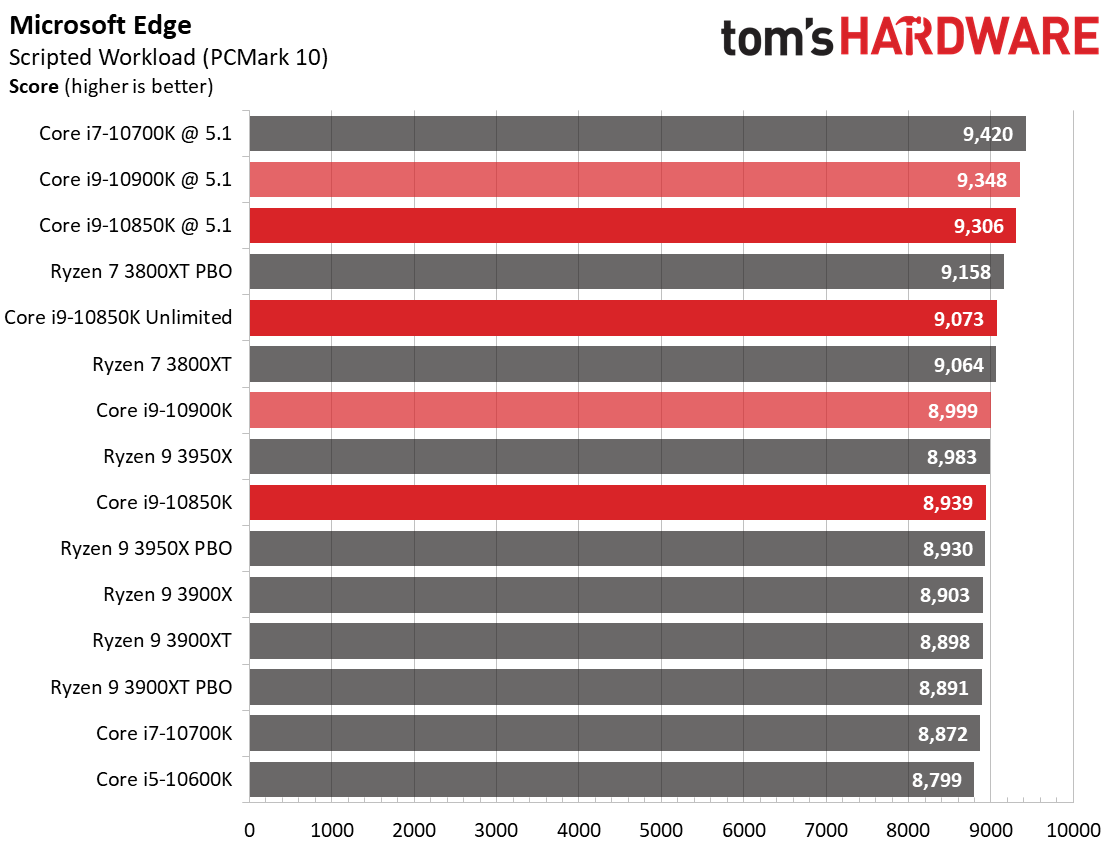
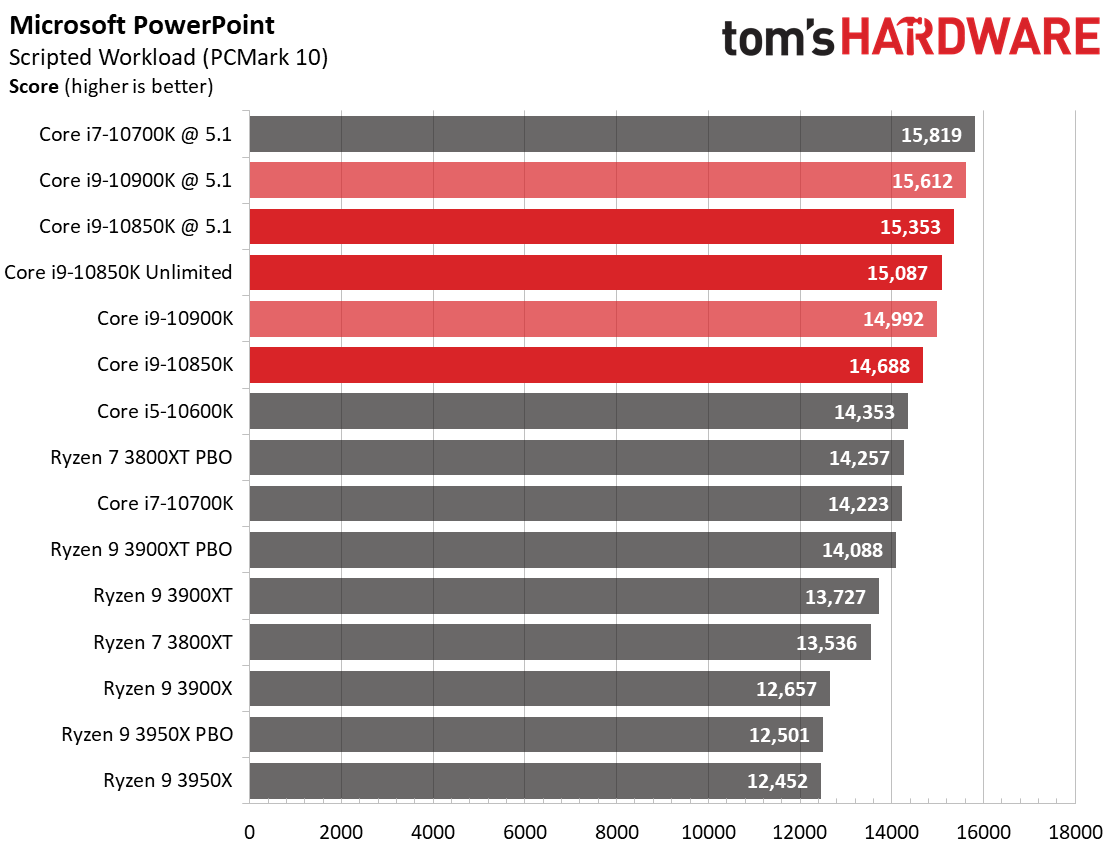
Turning to a suite of tests that largely respond to better per-core performance (a mixture of frequency and IPC), we can see the Core i9-10900K's 100 MHz boost advantage come into play a bit more.
The 10900K's higher boost grants it the lead in most of these tests, but we should keep that in perspective. In most cases, the deltas are slim and often fall either in, or right outside of, the expected run-to-run variance.
Core i9-10850K Power and Thermals
Just like the Core i9-10900K, the Core i9-10850K will run right at the limit of your cooling solution if it doesn't have enough available thermal headroom. We used the 280mm Corsair H115i water cooler with the fans cranked to full blast for testing, and just like with the 10900K, the 10850K pushed up to 100C during any type of AVX stress test. That results in thermal throttling that reduces performance over long-run benchmarks. As such, more capable coolers, like 360mm AIOs and custom loops, could expose yet more performance - and power consumption.
Stress tests often don't correlate to real-world heat output, though, and we recorded a peak of 91C during an extended multi-threaded y-cruncher workload (AVX heavy).
That means you'll need to bring your A-game in terms of cooling, motherboard, and power supply if you want to unlock the utmost performance from the Core i9-10850K at stock settings, not to mention if you plan on any meaningful overclocking.


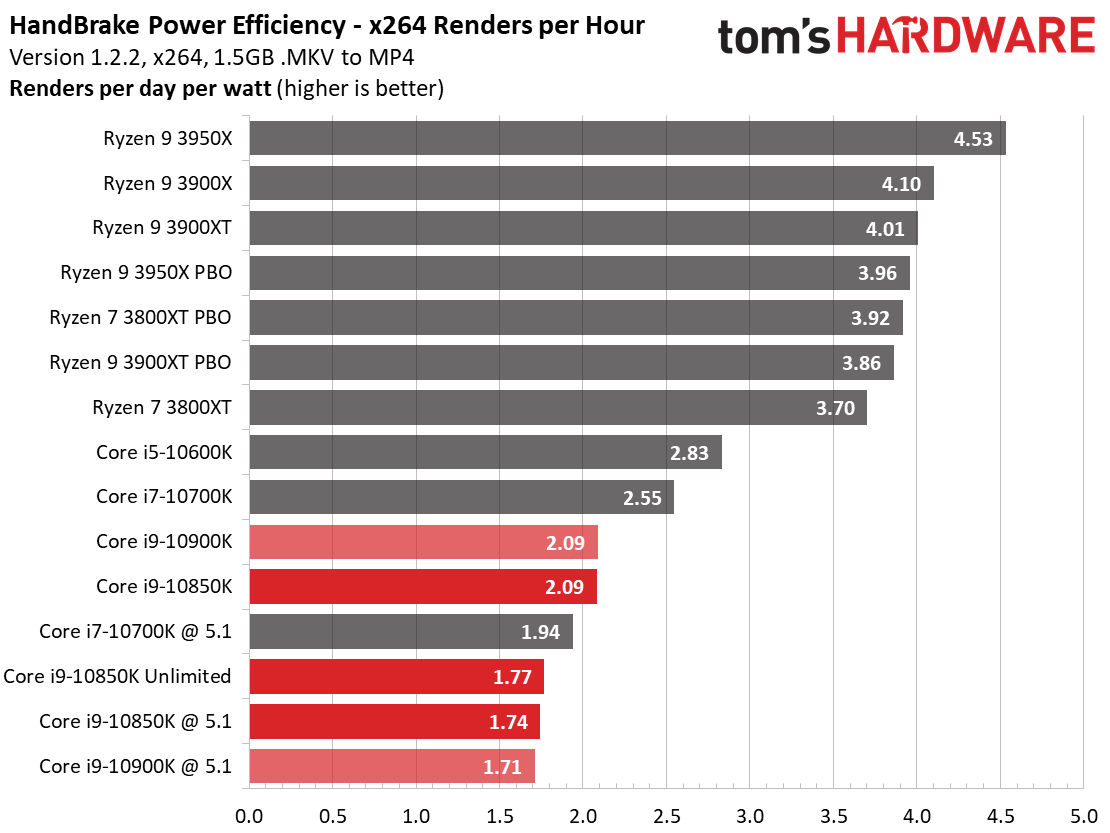
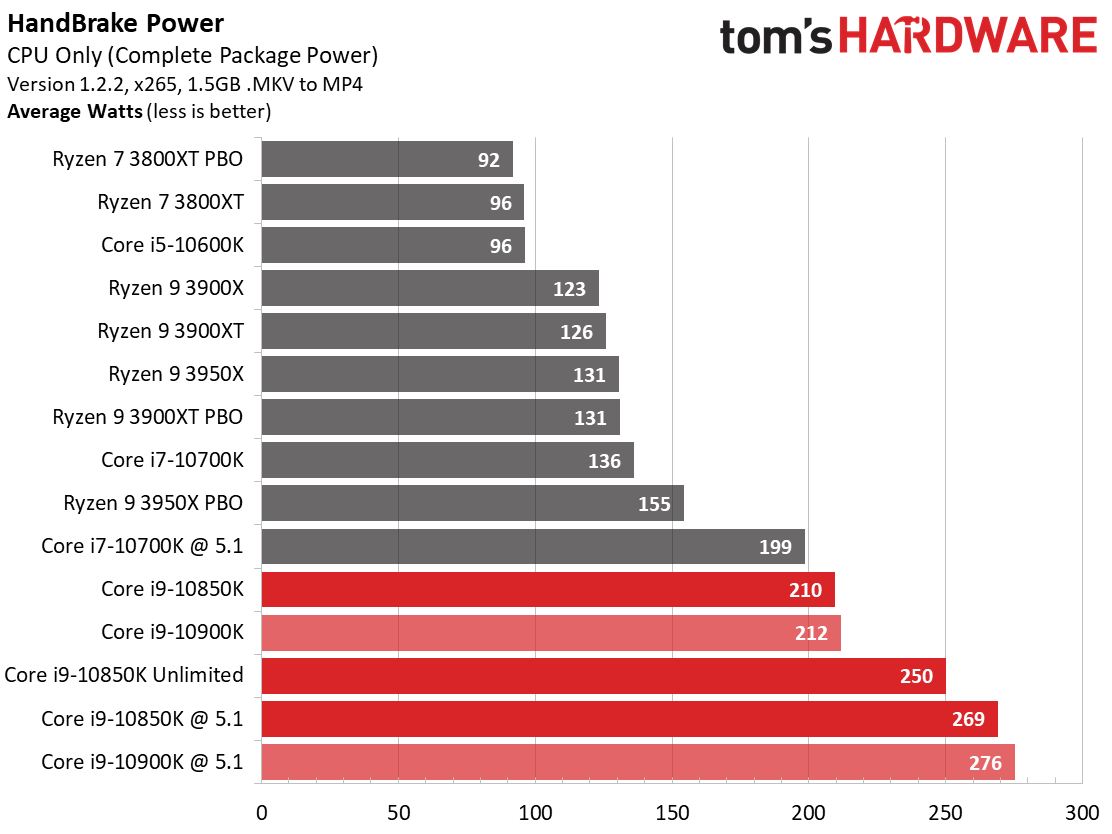

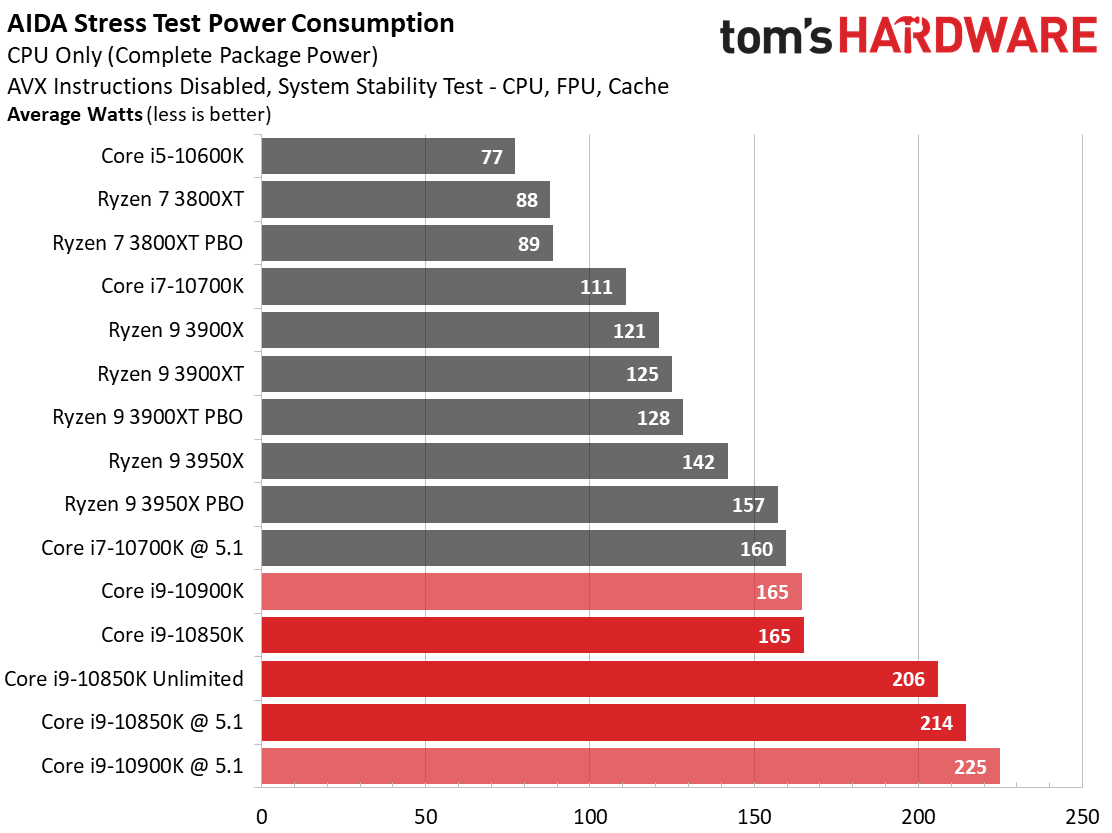
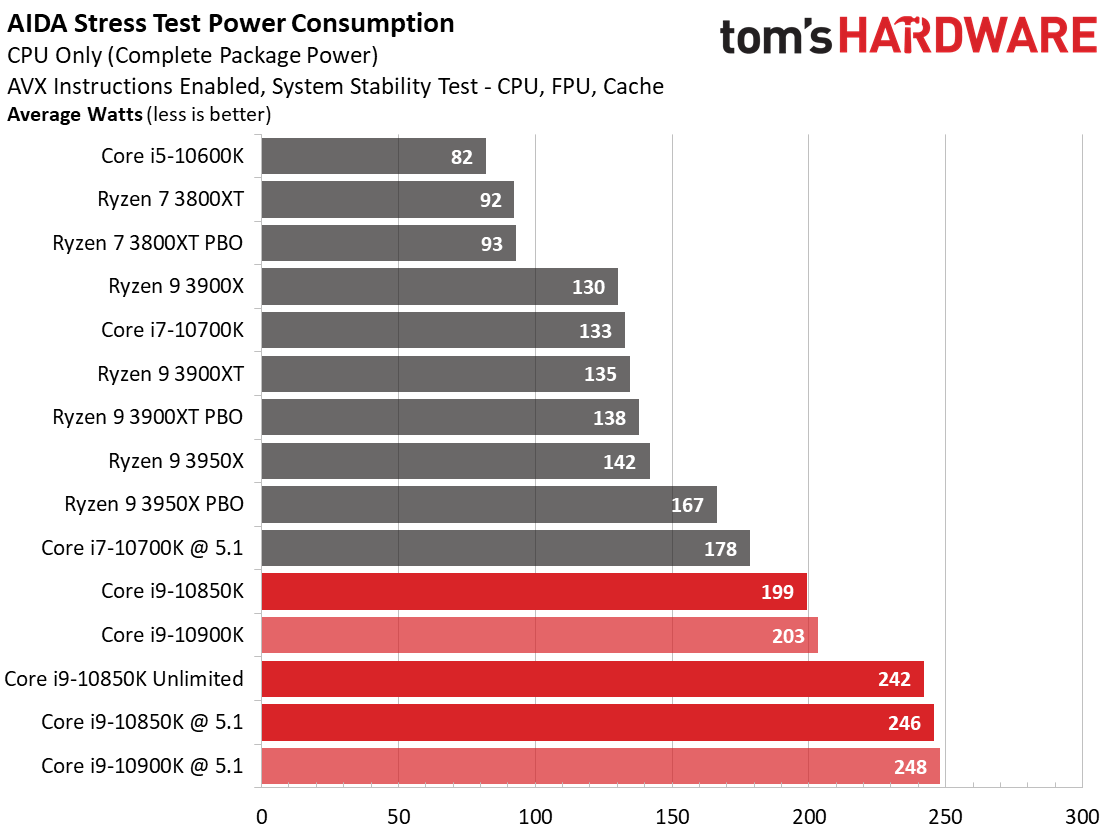
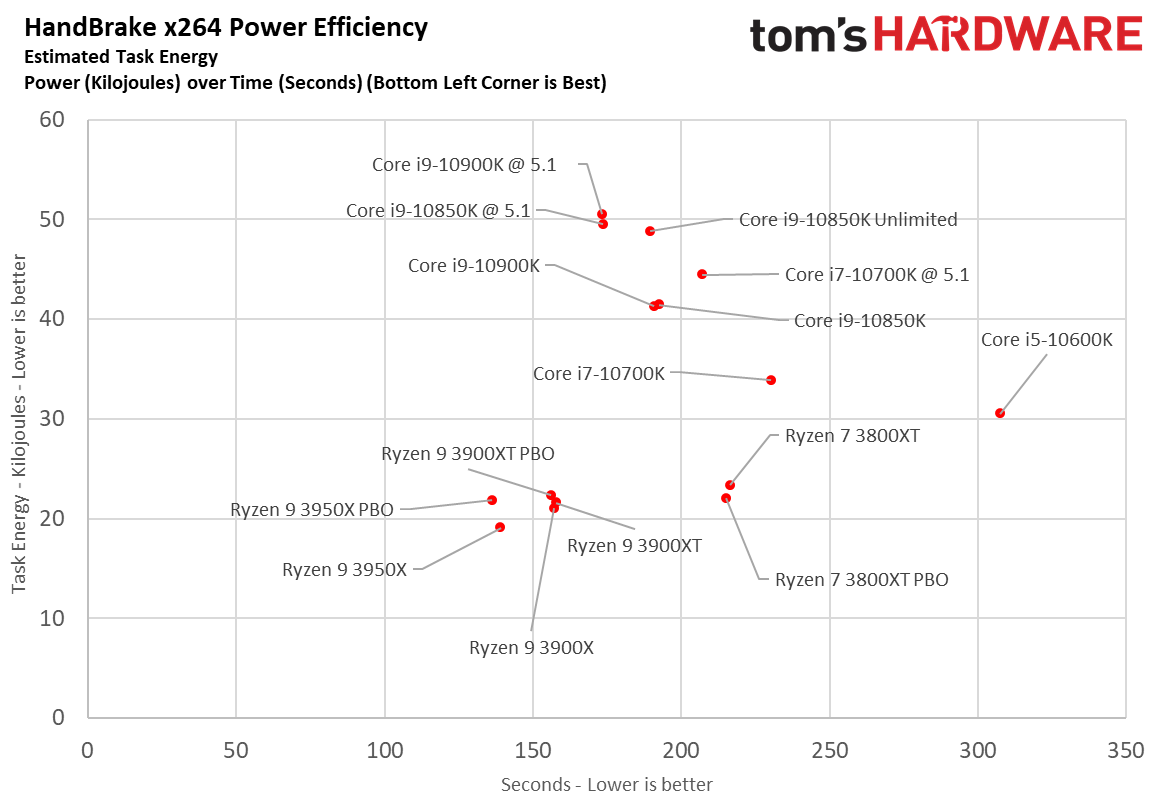
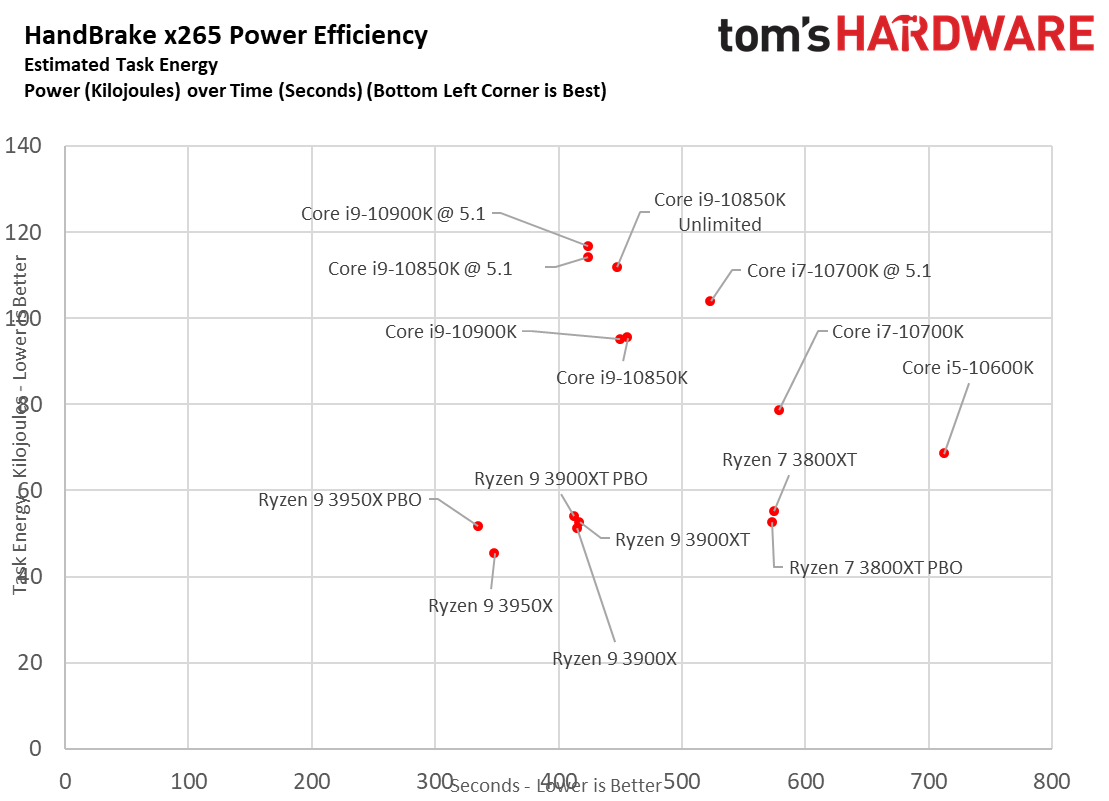
As expected, the 10850K pulls less power than the 10900K under full load, but we're looking at a roughly ~3% decrease in power consumption during the threaded AVX-heavy y-cruncher and HandBrake benchmarks.
You'll also notice that the "10850K Unlimited" configuration, which we achieved by removing all power limitations in the BIOS, draws nearly as much power as the Core i9-10900K and 10850K's all-core overclock, but didn't provide as much performance uplift in our tests. This implies that allowing the chip to use its own internal mechanisms to run without power limitations isn't as efficient as dialing in a manually-tuned overclock, but that really isn't too much of a surprise: Even though overclocking headroom has diminished with Intel's latest round of chips, manual overclocking still has benefits.
If you're after better power efficiency, and thus a cooler and quieter machine that still has plenty of performance, turn to AMD's Ryzen line of chips. As you can see in our final two scatter charts, which measure the cumulative amount of energy required to perform an x264 and x265 HandBrake workload, respectively, AMD still holds the unequivocal lead.
Core i9-10850K Conclusion
The below series of charts show a geometric mean of performance in our multi- and single-threaded workloads, along with the totals from our gaming testing.
At stock settings, there really isn't enough of a performance gain in multi-threaded workloads to justify the 10900K's premium pricing over the 10850K. However, the gains are more pronounced in inherently lightly-threaded applications.
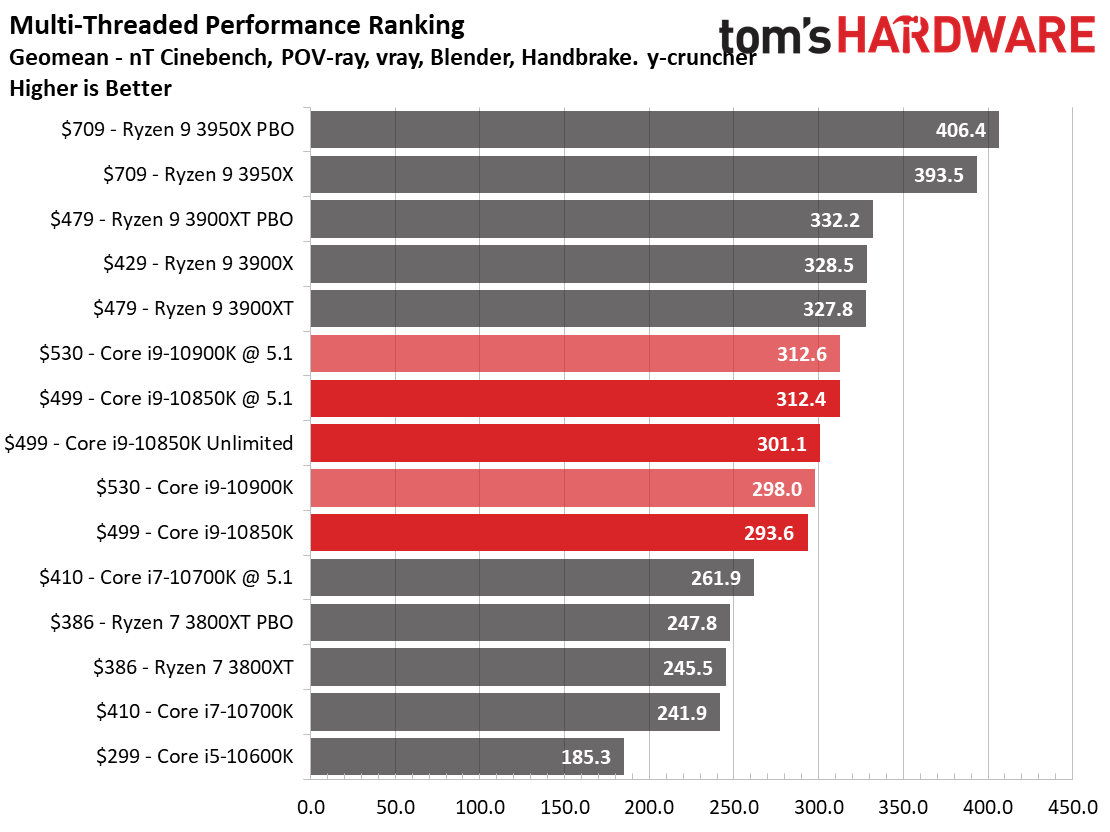


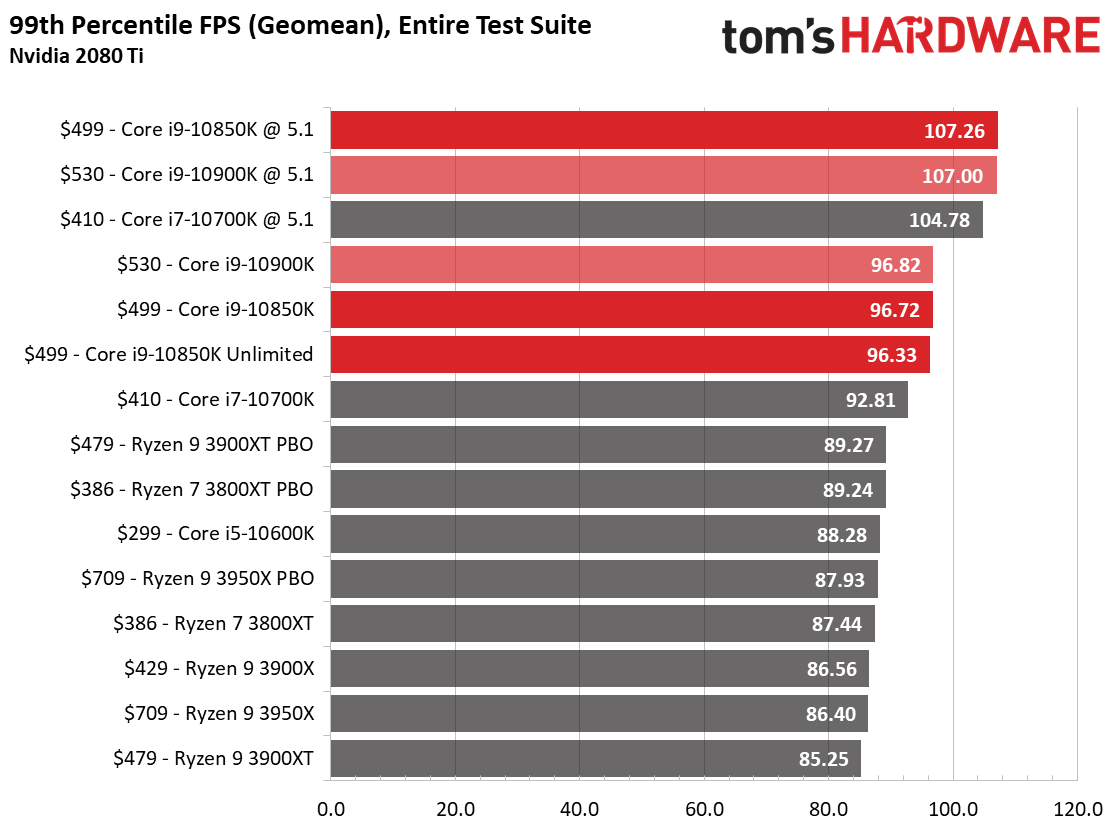
In our opinion, AMD's recent Ryzen XT lineup didn't change the performance calculus much. Outside of a few exceptions in professional workloads, those chips offer a negligible performance increase in most real-world applications, but at an increased price point. As such, we still recommend AMD's standard X-series models for the best value.
Intel takes the opposite approach with the Core i9-10850K. The 10850K comes with negligible reduction in performance that often falls into the imperceptible range for gaming, but the chip comes with a $30 price reduction compared to the 10900K. If Intel can actually keep the 10850K in stock, we could see that pricing delta widen at retail. As such, the Core i9-10850K is a better value than the 10900K for most enthusiasts, and is definitely a better value for casual users that aren't interested in overclocking.
Of course, the other caveats of the 10900K still apply. The Ryzen 9 3900X still offers the best all-around value and currently retails for ~$75 less than the Core i9-10850K, you just won't get the 10850K's bleeding-edge frame rates in gaming or the same level of single-threaded performance. The 10850K's extra gaming performance might come in handy with the new wave of Nvidia Ampere and AMD Big Navi graphics cards coming to market. It goes without saying that Intel still holds the uncontested lead in overclocking, but considering the 10850K's still-excessive power consumption, heat generation, requirement for pricey supporting components, and lack of PCIe 4.0, most enthusiasts are probably better served with less exotic alternatives, though.
If you stick strictly to team blue, the Core i7-10700K offers the lion's share of Core i9 gaming performance, but isn't nearly as demanding in terms of supporting components and power consumption (it also doesn't run as hot). It's also worth mentioning that the Core i5-10600K is an exceptional value for gaming - particularly if you overclock.
The story changes a bit for performance fanatics. If you're dead set on the best single-threaded and gaming performance available, regardless of the trade-offs, the Core i9-10850K is a worthy alternative to the i9-10900K. And you might actually find it in stock at retailers, which might be it's biggest advantage over the Core i9-10900K.

Paul Alcorn is the Editor-in-Chief for Tom's Hardware US. He also writes news and reviews on CPUs, storage, and enterprise hardware.
-
PCWarrior Why no benchmarks about Winrar? Last time I checked, Winrar compressed the files both to a smaller size AND faster. And please don't tell me that garbage excuse that Winrar is not free because (i)you can use it perpetually for free and (ii) since when do we only benchmark free software? Also, Winrar is far more popular. I know that everyone in a tech forum is like “I use 7zip” much like “I use Linux”, but if you step outside the forum bubble universe the majority of people use Winrar. Also the majority of downloads of compressed folders is in rar format and Winrar decompresses those faster than 7zip does.Reply
Ah, and below is how Intel and AMD fair in Winrar. The 10900K is 2.94x faster than the 3900X in single-threaded and 1.82x in multithreaded. In percentages we are talking about 194% and 82.3% faster respectively. But yeah let’s say nothing about it but only test 7zip where AMD does well. In particular AMD is 63%/30% faster in compression/decompression at stock vs stock and 35.7%/ 25.1% in OC Vs OC. Good wins but much smaller over the ones Intel achieves in Winrar.
-
TerryLaze Reply
Well winrar doesn't use a 32Mb dictionary that fits completely into a CCX cache while being twice the size of intel's cache so of course it makes a much better software for real world benchmark,who works with more than 32Mb of data anyway.PCWarrior said:Why no benchmarks about Winrar?